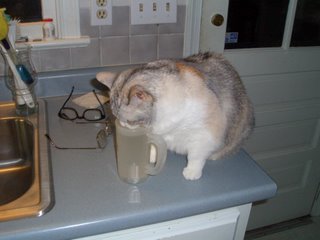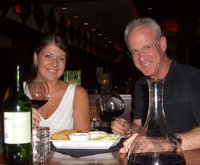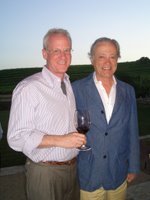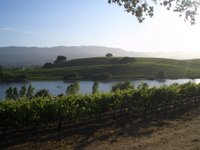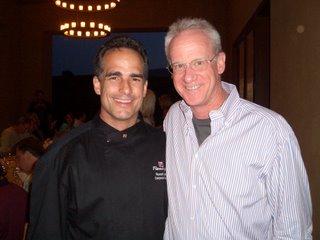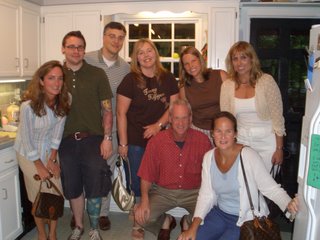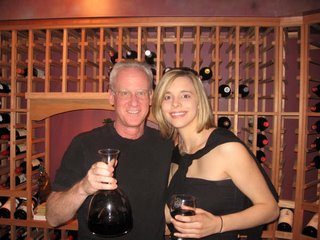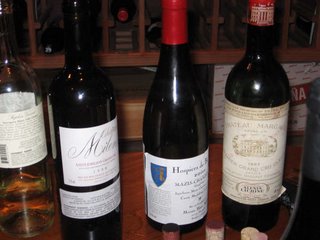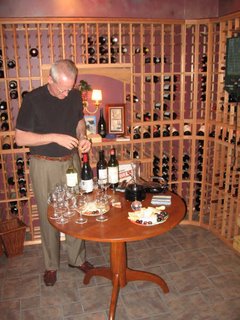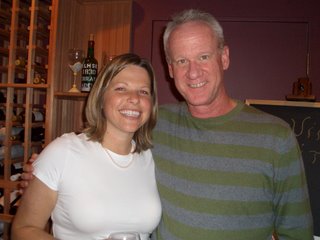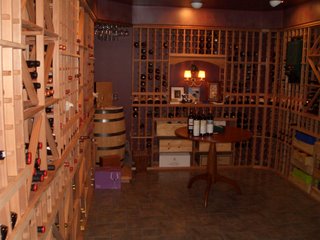
Wednesday, December 20, 2006
Flying off into the Sunset
There are some cool pictures of my last flight at a friend's website. Click this link to see them.
As with most of my career with The Martin Agency, the flight went safely, but not particularly in accordance with the original plan. We were taking the Chairman and his wife to NY for a dinner, and upon trying to return, Richmond was shut down in fog. So we hustled some hotel rooms for everyone, and tried again in the morning. Kate Meacham, from our "First Monday" wine group, was the Air Traffic Controller on duty for the Richmond landing, and you need to see the pictures to see what she set up for my last flight. It was a touching ending to a fine career. Many thanks to all who made it safe and meaningful.
As with most of my career with The Martin Agency, the flight went safely, but not particularly in accordance with the original plan. We were taking the Chairman and his wife to NY for a dinner, and upon trying to return, Richmond was shut down in fog. So we hustled some hotel rooms for everyone, and tried again in the morning. Kate Meacham, from our "First Monday" wine group, was the Air Traffic Controller on duty for the Richmond landing, and you need to see the pictures to see what she set up for my last flight. It was a touching ending to a fine career. Many thanks to all who made it safe and meaningful.
It's Freezing, Part Deux
The great thawing finally took place. Read back to the blog title about Freezing Wines to catch up on the reasons for the experiment. I thawed each bottle at room temperature, though I am told the microwave thaw cycle is no problem as long as you have VACCUSEALED. Both wines had been frozen for 5 weeks when I finally got to them, a point where they would certainly have been toast if left using standard methods of preservation. Results were mixed. The Red was fine, every bit as good as when it went in. The white, while tasting fine, did indeed have the expected tartaric acid crystals in the bottle. Not just a few, but maybe a half inch coating the bottom of the bottle. Every pour stirred them up, and clouded the wine. It was hard to conceive that you would find that appetizing to see when pouring into a glass. Perhaps decanting, but we have already gone to so much trouble, you certainly would say "Forget it! Open something else".
So, for a valuable red that you just can't finish over a couple of days, freezing is worth a try. For a white, not so much. Time to make white wine vinegar.
So, for a valuable red that you just can't finish over a couple of days, freezing is worth a try. For a white, not so much. Time to make white wine vinegar.
Saturday, December 09, 2006
Off To The Pasture
One more week of avaition for your Mayor, and then it's off to see what's next. This has been an interesting time for me. A fond farewell from the Agency yesterday and a few small parties to attend for the holidays to say my good byes. I had originally decided to take a few months off, figuring my next opportunity would present itself. But then the Tax Bug bit and I decided to work the season at HR Block, so I start training next week for that. Probably not a lot of corporate tax returns, but it'll be eye opening to have to work at a desk for a while. They end their season around Feb. 23rd for us first year guys, so it won't be that tough. Apparently the rush is the first two weeks in February. It's amazing how much sleep I have lost over this whole thing. But as it comes to fruition, there's light at the end.
On the Wine front, there's a fun tasting in January at Fleming's which will secondarily celebrate my recent 50th Bday. Come by on the 8th from 530 til 7.
On the Wine front, there's a fun tasting in January at Fleming's which will secondarily celebrate my recent 50th Bday. Come by on the 8th from 530 til 7.
Friday, November 17, 2006
Wine Spectator's Wine of the Year
Casanova di Neri Brunello di Montalcino 2001
Dark color with intense blackberry, chocolate and lightly toasted oak. Full-bodied and ultravelvety, with caressing tannins. Vanilla, chocolate and berry. Goes on for minutes. Best after 2010. 4,830 cases made.
Dark color with intense blackberry, chocolate and lightly toasted oak. Full-bodied and ultravelvety, with caressing tannins. Vanilla, chocolate and berry. Goes on for minutes. Best after 2010. 4,830 cases made.
Wednesday, November 15, 2006
Bin 22, Beaujolais Nouveau, and Other Stuff
This week is the annual unveiling of Beaujolais Nouveau. Thursday night I'll be at Wine Lover's on 2284 John Rolfe Parkway to taste Chris' selection in the weekly tasting. Come up and join us starting at 530 til about 7! I'm looking for those who attended the BIN 22 Italian Wine Tasting to use the COMMENT area below to tell us about the dinner last night. Jom Opalka is one of my current favorite distributors, and I'd love to hear about the event. We at the Fleming's Wine Spectator 90+ dinner enjoyed those pairings. Five distinct wines with the always eclectic foods that Fleming's rolls out for these dinners. By the way, use this link to track the countdown to the Wine Spectator Top 10 of this years Top 100 this week!
Sunday, November 05, 2006
Wine Chemistry 301
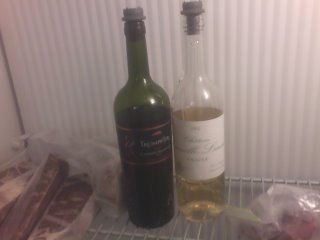
Ok, my estudiantes, this week let's get together and do a Chemistry experiment. We are going to freeze two opened bottles of wine and see if this is a "reasonable" way of saving wine over a long period of time, one which exceeds normal expectation. We know that oxygen is the enemy of opened wines, and that oxidation gives wine that vinegar taint over time. When we freeze wine, having first minimized the amount of air in the freezing vessel, we minimize the long term contact with oxygen in two ways: the vacuum itself minimizes some of it, and the solid nature of the ice keeps oxygen from permeating the wine. What we hope will happen is that the wine will, upon thawing, approximate a smaller diminution of flavor than if had been ruined by leaving in a liquid state. Join me in taking a partially consumed Red and White and let's freeze it for the next two weeks. Because of the properties of freezing, be sure to Vaccu Seal the bottle, or consider placing the wine in a plastic bag that has had most of the air removed. Leave some space for expansion though.
One thing we can expect is that in the process of freezing, the water in the wine will freeze prior to the alcohol. This, I'm told will allow some of the solids in the wine to "precipitate out", forming small crystal in the thawed wine. It is my understanding that these are tartaric acid crystals, and are tasteless. This will be the only flaw to the texture, but I'm told that the finished product can actually improve in taste because of the decrease in acidity! Well, we shall see! I take no responsibility for any broken bottles. Please Vaccu Seal the wine to preclude that!
When we are ready to thaw the wine...I'll have some techniques for that too, which even include the microwave! I think you will be amazed at the outcome.
The last thing that is important is to make notes about how the wine tastes before the freezing so we can compare. I have chosen a Argentine Cabernet Sauvignon, and a Bordeaux White, which is Semillon and Sauvignon Blanc. The latter is young and acidic, so we shall see if we lose too much character by losing the acid. The Cab is a typical South American with a light style and nice dark fruits. Very light tannins make this a candidate for storing in an unconventional way, because tannins would help to keep it from spoiling too quickly if left at room temperature.
See you in two weeks!
Friday, November 03, 2006
Hard At Work
Wednesday, November 01, 2006
Food/Wine Synergy
Lately, we have been concentrating on food and wine pairings at many of my haunts around town. Most of you have, by now, been introduced to my pairing with White Zinfandel, and the surprising result that it brings. We examine the intricacies of acid and salt in foods and how they affect wine. Further, oak in red wines affects spicy foods in surprising ways. We know that in the “old world”, wine is generally made in a style which will compliment food, specifically the foods of the region from which they come. Rhones with the local peasant dishes, crisp whites from areas near great seafood, and hearty reds where lamb and beef is raised. Is there any doubt which wines pair best with classic Italian dishes? Keep these generalities in mind while you cook this week. In what region is your main dish most successfully grown or raised? Grab a “local” wine and see if it doesn’t make the whole meal balance.
Saturday, October 28, 2006
Acacia Wine Dinner Nov. 1st
Acacia announces a three course mini wine dinner Wednesday November 1st! Dale has put together a wonderful fall menu to compliment these delicious california wines. Clement Brown from Virginia Distributing will be on hand to answer your questions about the wines. Reservations will be required and the event will cost $32per person. For attendees of the tasting only these wines will be available to order from River City Cellars at a special price. We look forward to seeing you.
Mini wine dinner November 1st:
salt roasted pears, belgian endive salad, creamy bacon dressing
Sauvignon Blanc, Sterling Vineyards, Napa Valley 2005
crepe stuffed with smoked salmon, cauliflower, basil sauce
Chardonnay, St. Clement, Napa Valley 2005
speckled trout, curry lentils, apples, raisins, eggplant chip
Pinot Noir, Solaris, Carneros 2005
or
boneless beef shortribs, braised cranberries, crispy potato gratin, swiss chard
Cabernet Sauvignon, Oberon, Napa Valley 2002
$32. Per person
and ALWAYS:TUESDAY nights HALF-PRICE wines by the bottle, when you order from our dinner menu or prix-fixe menu.
three-course PRIX-FIXE menu $21.95 MONDAY-THURSDAY 5:30-9pm and FRIDAY and SATURDAY 5:30-6:30
MINI WINE DINNER Wednesday November 29th. more info to follow Remember....We are available for parties of any occasion, in your home or at our restaurants.
Please call 354.6060.
Mini wine dinner November 1st:
salt roasted pears, belgian endive salad, creamy bacon dressing
Sauvignon Blanc, Sterling Vineyards, Napa Valley 2005
crepe stuffed with smoked salmon, cauliflower, basil sauce
Chardonnay, St. Clement, Napa Valley 2005
speckled trout, curry lentils, apples, raisins, eggplant chip
Pinot Noir, Solaris, Carneros 2005
or
boneless beef shortribs, braised cranberries, crispy potato gratin, swiss chard
Cabernet Sauvignon, Oberon, Napa Valley 2002
$32. Per person
and ALWAYS:TUESDAY nights HALF-PRICE wines by the bottle, when you order from our dinner menu or prix-fixe menu.
three-course PRIX-FIXE menu $21.95 MONDAY-THURSDAY 5:30-9pm and FRIDAY and SATURDAY 5:30-6:30
MINI WINE DINNER Wednesday November 29th. more info to follow Remember....We are available for parties of any occasion, in your home or at our restaurants.
Please call 354.6060.
Tuesday, October 24, 2006
Top Dog On The Value Wine List

Well you may have seen my hint a few weeks back, and the last few wines that came to my attention did not dissuade me from my Top Value Wine Pick from the list submitted by the faithful readers herein. Here are my comments about the winner of the flight:
Montecillo Crianza 2002 (Spanish Rioja)
An Official Top Dog of the tasting group. This Spanish Rioja from Kroger and Total Wine is silky, soft and structured, with great notes of medium red fruits and just enough tannin to make me swoon. Tempranillo very often taste cheap when in the Crianza style, meaning released in it’s third year, with at least one year in oak. The next step up would be Riserva, and not fall into our price category. This is an awesome find, and I’m buying by the case. By the way, the 2001 was the actual wine submitted. If it’s any better than this…Wow (95)
Thanks to Kristen Kelly and Barbara Garazo for submitting this wine. I have now tasted the 2001, and the 1998 Riserva, both of which are available at Total Wine. The Riserva prices a bit higher, about $18.
Wednesday, October 18, 2006
Fleming's Featured Customer
The Fleming's Quarterly Newsletter is out, and your Mayor is featured in a short Q and A. As you all know, my humble beginnings at Fleming's have grown to this auspicious honor of bringing you the latest Richmond Wine News and my take on general wine theory. Please stop by Fleming's and ask to see a copyof the Newsletter, and consider joining in for the fabulous Wine Spectator 90+ Wine Dinner in November. Awesome wines and an awesome menu.
Tuesday, October 17, 2006
Bonny Doon Is An Odd Place
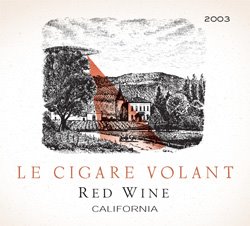
In an effort to market to the "millenial" market, those turning 21 in the years from 2000 - 2010, Bonny Doon and other wineries get edgy with their Brand. Check out this example. The Millenials are the largest generational market since the baby boomers, numbering about some 20 million Americans. Wine is the drink of choice among this new set, and they are spending more to quench their thirst. Those aged 21 to 34 are 84% more likely to spend $20 or more for a bottle of wine than those 35 or older. Pizza Pairings and impish names are the latest marketing techniques to get wines noticed. Spaceships over Chateauneuf du Papes are just a beginning of the invasion. Buy a Millenial a glass next time you see one perusing the bar's wine list. Or better yet, ask to have a taste of what he's paying for. It's probably more expensive than yours!
Monday, October 16, 2006
A Hint About The Value List
Spain has always been one of my favorite wine producers. It suits my old world style, and there are cutting edge wine makers plying their trade with new exciting ideas. There are more acres of grapes in Spain than any other country, but their total wine production trails France and Italy.
The styles of Spain's wines are evolving. Once known for high alcohol reds and low acid whites, they now are working to entice the taste styles of the world wide market. Government regulations have created higher quality ratings, and the lesser appellations have been properly demoted. Once requisite long oak aging rules have been relaxed and now more fruit is accessible in these wines. While each controlled appellation (DO) has it’s own specific rules, generally they follow a common theme.
Crianza style wines are released in their third year typically, and have generally have about one year in oak. Crianza is the Spanish word for “breeding”, and wines that are released prior to two full years of aging carry the words “sin crianza” (without breeding) on their label. Riservas must be at least three years old and also require one year in oak. The Crianza style is generally more desirable in the American market, although Riservas are considered better wines. Try out a crianza rioja for an affordable interesting old world play.
The styles of Spain's wines are evolving. Once known for high alcohol reds and low acid whites, they now are working to entice the taste styles of the world wide market. Government regulations have created higher quality ratings, and the lesser appellations have been properly demoted. Once requisite long oak aging rules have been relaxed and now more fruit is accessible in these wines. While each controlled appellation (DO) has it’s own specific rules, generally they follow a common theme.
Crianza style wines are released in their third year typically, and have generally have about one year in oak. Crianza is the Spanish word for “breeding”, and wines that are released prior to two full years of aging carry the words “sin crianza” (without breeding) on their label. Riservas must be at least three years old and also require one year in oak. The Crianza style is generally more desirable in the American market, although Riservas are considered better wines. Try out a crianza rioja for an affordable interesting old world play.
Friday, October 13, 2006
The Wine Value List
In my weekly newsletter, I have asked my readers to send to me the value wines that they like, those under $12 that make them shout out. I've received some super replies, and I'm happy to be releasing their pleasures soon, probably next week. I'm tasting each and everyone one of the wines and rating them. To get the list, you must send me a wine. It's only fair! I'll list my comments and return the full list to anyone who sends in a wine. If you are not on the Newsletter list, pop me an email or reply to this message with your email addy. Now I'm off to Fleming's for a glass or two and a big ole piece o' cow.
Sunday, October 08, 2006
Friday, October 06, 2006
Leave it to China
Beijing - The French used grapes, Russians fermented potatoes, Koreans put ginseng in their drink and Mexicans distilled cactus plants to make fiery tequila.Now China is introducing fish wine.Sun Keman, an entrepreneur in the north-east port city of Dalian, has formed the Dalian Fisherman's Song Maritime Biological Brewery, with a plan to use his background in the fishing industry to make fish into wine."Different from China's thousands of years of brewing, the brewery will clean, boil, and ferment fish for making wine," the official Xinhua news agency reported.The company already had orders from Japan, Russia and other parts of China, it said.Tipplers might also take heart in knowing the brew is purported to be good for them."Experts said the wine is nutritious and contains low alcohol," Xinhua said.
Saturday, September 30, 2006
So Many Tasting Venues!
There are LOTS of new and old Tasting Venues in Richmond these days Thought I'd update you on my list:
Bin 22 - Tuesday thru Saturday evenings, extensive by the glass list of eclectic offerings, including sparklers. Tuesday is $1 off all glasses. Wednesday is half price bottles. Auburn and Cary Sts, in Carytown. This is a Mayoral Favorite.
Fleming's Prime Steakhouse and Wine Bar - First Monday of each month free tasting from 530-700. Wines paired with excellent munchies. Third Wednesday of each month is the Charity Wine Night, with a Special List of Reserve Wines offered by the glass, with every nickle going to a local charity. Great opportunity to try Reserve Wines, without having to take out a mortgage. Stony Point Fashion Mall www.flemingssteakhouse.com
Cafe Gutenberg - WineDown Wednesdays, half price wine by the glass, 5-10pm. 17th and Main www.cafegutenberg.com
Can Can Brasserie - Monday 6-7 PM $1. Art Tuesdays with tasting 6-7, specific Tuesdays. Check Schedule. www.cancanbrasserie.com
Kroger Carytown - Friday 4-7 PM wines with cheeses. Join Terry Loveland in the newly refurbished store with temperature controlled Reserve Room.
Wine Lovers - Thursday 530-7 PM wine with discussion, local distributors and wine specials. John Rolfe Parkway
The Wine Cellar - Jeff Aumen hosts wine tastings on Fridays, 5 til 8. Midlothian near Sam's Club.
River City Cellars - Friday 5-7 pm www.rivercitycellars.com
Bin 22 - Tuesday thru Saturday evenings, extensive by the glass list of eclectic offerings, including sparklers. Tuesday is $1 off all glasses. Wednesday is half price bottles. Auburn and Cary Sts, in Carytown. This is a Mayoral Favorite.
Fleming's Prime Steakhouse and Wine Bar - First Monday of each month free tasting from 530-700. Wines paired with excellent munchies. Third Wednesday of each month is the Charity Wine Night, with a Special List of Reserve Wines offered by the glass, with every nickle going to a local charity. Great opportunity to try Reserve Wines, without having to take out a mortgage. Stony Point Fashion Mall www.flemingssteakhouse.com
Cafe Gutenberg - WineDown Wednesdays, half price wine by the glass, 5-10pm. 17th and Main www.cafegutenberg.com
Can Can Brasserie - Monday 6-7 PM $1. Art Tuesdays with tasting 6-7, specific Tuesdays. Check Schedule. www.cancanbrasserie.com
Kroger Carytown - Friday 4-7 PM wines with cheeses. Join Terry Loveland in the newly refurbished store with temperature controlled Reserve Room.
Wine Lovers - Thursday 530-7 PM wine with discussion, local distributors and wine specials. John Rolfe Parkway
The Wine Cellar - Jeff Aumen hosts wine tastings on Fridays, 5 til 8. Midlothian near Sam's Club.
River City Cellars - Friday 5-7 pm www.rivercitycellars.com
Sunday, September 24, 2006
The Night They Got It Wrong
I'm at The Homestead, a resort in the mountains of Virginia which competes with the likes of the Greenbriar and the Inn at Little Washington for it's clientele, and competes well. Like a 1930's style resort with charming art deco interiors and classic club style exteriors, they exude the style and grace one expects of genteel southern charm. Tonight's wine list lived up to the surroundings. BW and I dined in the 1766 Grille, their upscale, quiet dining room with tableside food prep and a Wine Spectator Wine List.
We have long ago decided that we differ on wine styles, so I ordered a Trefethen Cabernet for her, hoping to appeal to her love of chocolate oak notes from California. And in my old world style, I chose a Northern Rhone Hermitage by Guigal. Hermitage means 100% Syrah, with Hermitage being arguably the best of show from the region. 2001 was a stellar year in Northern Rhone, and most of the wines form the region are drinking solidly right now. Guigal is a large producer with a reputation of fine sturdy wines, and excellence, including a recent Wine of Year on Wine Spectator's Top 100 List.
The 2001 Guigal Hermitage is rated 90 by Parker and prices out at about $65 retail. It was $83 on the list, so for a resort, it was well priced. Unfortunately, my cocktail waiter either misheard my order or grabbed form the wrong bin a Gigondas by another maker. Not even close to what I ordered, this is a Southern Rhone made from grenache and syrah, and prices at about $25 retail. He left to find the right wine, with a glance at the menu for guidance and a bin number. Alas, his return was closer, but no more correct. Guigal's Crozes Hermitage from 2002 was presented, and he started slicing the capsule before I could quickly tell him that this also was not correct. While similar, and 100% syrah, this is one of the lesser appellations of the Northern Rhone, and an inconsistent year as well. Certainly not the gem that I ordered. We summoned a Sommelier to help us now, and he insisted that he did indeed have the wine I wanted, and he would bring it if I still wanted it. Perfect! Once again though, we got ever so close without success. He brought me the correct Hermitage, but also from 2002, our also-ran vintage. Now I understand vintages change, and these things happen. But it galls me when the quality of the year change is not reflected in the price. The 2002 Guigal Hermitage rates an 86 from Parker, and is available retail for about $50. Nice enough, but not the wine I ordered. Not until I pointed out the difference did our server discount the wine. He did offer us a complimentary split of a Guigal Condrieu white, for "all the confusion". This was a perfect gesture, and while we declined, the service excellence of the Homestead shown through for a glimmering moment. He opened and poured a small bit of my Hermitage for me to taste, and I was happy to find the wine without flaws. My Sommelier then smiled and placed the bottle on the table and exited the scene, neglecting to fill my now dry glass! BW was quick to notice the lapse and asked appropriately, "Did he just say F*** You, in winespeak?"
Perhaps he did. Perhaps he had the last laugh, and maybe he just forgot. Regardless, I tell the story, and will recall the time The Homestead got it wrong. I bet it's rare.
We have long ago decided that we differ on wine styles, so I ordered a Trefethen Cabernet for her, hoping to appeal to her love of chocolate oak notes from California. And in my old world style, I chose a Northern Rhone Hermitage by Guigal. Hermitage means 100% Syrah, with Hermitage being arguably the best of show from the region. 2001 was a stellar year in Northern Rhone, and most of the wines form the region are drinking solidly right now. Guigal is a large producer with a reputation of fine sturdy wines, and excellence, including a recent Wine of Year on Wine Spectator's Top 100 List.
The 2001 Guigal Hermitage is rated 90 by Parker and prices out at about $65 retail. It was $83 on the list, so for a resort, it was well priced. Unfortunately, my cocktail waiter either misheard my order or grabbed form the wrong bin a Gigondas by another maker. Not even close to what I ordered, this is a Southern Rhone made from grenache and syrah, and prices at about $25 retail. He left to find the right wine, with a glance at the menu for guidance and a bin number. Alas, his return was closer, but no more correct. Guigal's Crozes Hermitage from 2002 was presented, and he started slicing the capsule before I could quickly tell him that this also was not correct. While similar, and 100% syrah, this is one of the lesser appellations of the Northern Rhone, and an inconsistent year as well. Certainly not the gem that I ordered. We summoned a Sommelier to help us now, and he insisted that he did indeed have the wine I wanted, and he would bring it if I still wanted it. Perfect! Once again though, we got ever so close without success. He brought me the correct Hermitage, but also from 2002, our also-ran vintage. Now I understand vintages change, and these things happen. But it galls me when the quality of the year change is not reflected in the price. The 2002 Guigal Hermitage rates an 86 from Parker, and is available retail for about $50. Nice enough, but not the wine I ordered. Not until I pointed out the difference did our server discount the wine. He did offer us a complimentary split of a Guigal Condrieu white, for "all the confusion". This was a perfect gesture, and while we declined, the service excellence of the Homestead shown through for a glimmering moment. He opened and poured a small bit of my Hermitage for me to taste, and I was happy to find the wine without flaws. My Sommelier then smiled and placed the bottle on the table and exited the scene, neglecting to fill my now dry glass! BW was quick to notice the lapse and asked appropriately, "Did he just say F*** You, in winespeak?"
Perhaps he did. Perhaps he had the last laugh, and maybe he just forgot. Regardless, I tell the story, and will recall the time The Homestead got it wrong. I bet it's rare.
Wednesday, September 20, 2006
Thursday, September 14, 2006
This Article From the Times Dispatch - Cordell's Wine Picks
Cordell Watkins, a bartender at Fleming's Prime Steakhouse & Wine Bar, suggests five wines with screwcaps. Fleming's operating partner John Van Peppen offers the food pairings. The wines can be found in some retail outlets in the area.
Yalumba 2005 unwooded Chardonnay (South Australia), $12.95: No oak, lots of green apple, some citrus-type notes. Would go well with crab cakes or Ahi tuna. Jumbo lump crab cakes with lime butter sauce pairs nicely with tropical flavors of the Chardonnay.
Conundrum 2004 white table wine (Caymus Vineyards, Rutherford, Calif.), $28.45: Blend of five varietals, puzzle as to percentages of the varietals; layered floral; tropical fruit; spicy; lush texture. Pairs with sweet chile calamari, which has a sweet chili sauce. Conundrum has enough residual sugar to balance quite nicely with that.
Kim Crawford 2005 Marlborough Sauvignon Blanc (New Zealand), $19.55: Big grapefruit with some underlying tropical-fruit notes; nose is so distinctive. Would go well with spicy food, such as Wicked Cajun Barbecue Shrimp, which has garlic and spice and a little heat. Sauvignon Blanc cuts through it nicely.
Zilliken 2005 Butterfly Riesling (Germany), $17.99: Medium dry. Not dry, not sweet, kind of in between; great floral aroma, apple, pear fruit, acidity. Pairs with seared scallops with a lobster cream sauce. The hint of residual sugar and floral nose on the Butterfly would enhance the scallops.
Longview Red Bucket 2005 Semillon Sauvignon Blanc (Australia), $11.99: Full-bodied with lots of tropical notes, pineapple, guava, spicy, too. Food pairing recommendations include Breaded Brie, almond crusted. Also, a chilled seafood tower that includes lobster, shrimp, lump crab and fresh oysters. Nice fresh, cool summer wine like this would work well. Prices may vary.
Yalumba 2005 unwooded Chardonnay (South Australia), $12.95: No oak, lots of green apple, some citrus-type notes. Would go well with crab cakes or Ahi tuna. Jumbo lump crab cakes with lime butter sauce pairs nicely with tropical flavors of the Chardonnay.
Conundrum 2004 white table wine (Caymus Vineyards, Rutherford, Calif.), $28.45: Blend of five varietals, puzzle as to percentages of the varietals; layered floral; tropical fruit; spicy; lush texture. Pairs with sweet chile calamari, which has a sweet chili sauce. Conundrum has enough residual sugar to balance quite nicely with that.
Kim Crawford 2005 Marlborough Sauvignon Blanc (New Zealand), $19.55: Big grapefruit with some underlying tropical-fruit notes; nose is so distinctive. Would go well with spicy food, such as Wicked Cajun Barbecue Shrimp, which has garlic and spice and a little heat. Sauvignon Blanc cuts through it nicely.
Zilliken 2005 Butterfly Riesling (Germany), $17.99: Medium dry. Not dry, not sweet, kind of in between; great floral aroma, apple, pear fruit, acidity. Pairs with seared scallops with a lobster cream sauce. The hint of residual sugar and floral nose on the Butterfly would enhance the scallops.
Longview Red Bucket 2005 Semillon Sauvignon Blanc (Australia), $11.99: Full-bodied with lots of tropical notes, pineapple, guava, spicy, too. Food pairing recommendations include Breaded Brie, almond crusted. Also, a chilled seafood tower that includes lobster, shrimp, lump crab and fresh oysters. Nice fresh, cool summer wine like this would work well. Prices may vary.
J. Emerson Changes Hands
Jim Tastian-Brown has sold the venerable wine store on "The Avenues" and Libbie and Grove. In his last newsletter Jim thanked his many customers and introduced the new owner. Staff will remain the same, and there may be some upgrades to the "non-wine" areas to better serve the local market. Jim has been a wonderful mentor to me, and will apparently now dabble in wine wholesaling and import. Best wishes to a good friend
Cordell and Cork
Cordell with Nicole Riedel, formerly of Osaka
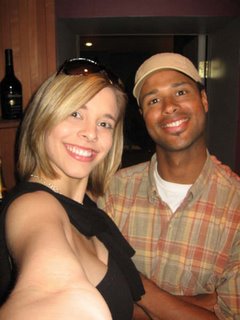
Hope you all saw the neat article in the Times Dispatch featuring our own Cordell Watkins from Fleming’s (Wednesday’s Flair Section). Cordell was explaining screw caps to the newspaper, dispelling the notion that the only good closure for wine is real cork. So many great products are on the market now to replace cork. As we begin to see cork prices increase, and collectors continue to be bedeviled by TCA or “cork taint”, screw caps and other cork replacements are becoming more popular and more effective at saving our treasures. Statistics vary, but as many as 5% of wines using real cork are found to have traces of TCA ( trichloroanisole), a compound which produces in wine a musty, wet basement aroma. The smell can also be described as wet newspaper or wet dog hair to some. Regardless, these “corked” wines are unsuitable for drinking, and can be very annoying to a collector who has put years of waiting into a rare vintage. When TCA creeps into a winery, the results can devastate an entire years production. While the original bacteria comes originally from cork, it can grow in the winery and become costly to get rid of. Sources estimate that the cost of cork taint to the wine industry reaches $100 million worldwide annually.

Hope you all saw the neat article in the Times Dispatch featuring our own Cordell Watkins from Fleming’s (Wednesday’s Flair Section). Cordell was explaining screw caps to the newspaper, dispelling the notion that the only good closure for wine is real cork. So many great products are on the market now to replace cork. As we begin to see cork prices increase, and collectors continue to be bedeviled by TCA or “cork taint”, screw caps and other cork replacements are becoming more popular and more effective at saving our treasures. Statistics vary, but as many as 5% of wines using real cork are found to have traces of TCA ( trichloroanisole), a compound which produces in wine a musty, wet basement aroma. The smell can also be described as wet newspaper or wet dog hair to some. Regardless, these “corked” wines are unsuitable for drinking, and can be very annoying to a collector who has put years of waiting into a rare vintage. When TCA creeps into a winery, the results can devastate an entire years production. While the original bacteria comes originally from cork, it can grow in the winery and become costly to get rid of. Sources estimate that the cost of cork taint to the wine industry reaches $100 million worldwide annually.
Friday, September 01, 2006
It's Not Always the Most Expensive Wines...
In Bentonville, Arkansas last night I perused the wine menu at The River Grille, a nice steak place with a Wine Spectator recognized list. The usual suspects were all there, Jordan, Silver Oak, Opus etc, but the Chilean part of the list caught my eye as a real price value. Concha y Toro makes what some might call "grocery store" wines. As a matter of fact, one of my favs when I first started drinking red wine was the 1.5 L version of their Cab/Merlot blend pricing out at about 9 bucks. My tastes these days enjoy the Marques de Casa Cabernet, one of their higher end wines. Higher end being relative, it priced out on this menu at $29. It's lush and gentle, a softer cab more in the old world style. I paired it with a nicely marbled Rib Eye and was happy to be on the value track for once. I don't usually review wines on here, but this is a wine you might want to hook into next time you see it. You don't have to fly to Bentonville to find it. I've seen it at Total and Kroger, and I'm betting your retailer can order it too.
Thursday, August 31, 2006
Meritage Wines and Pronunciation
When we see proprietary names on wine bottles, name like Insignia from Joseph Phelps or Opus One from the formidable duo of Mondavi and Rothschild, these names are chosen many times because they lack the required percentage of any one grape which would allow them to be called by the varietal name. A special group of these wines choose to emulate the blends of grapes made popular in Bordeaux. If they comply with certain standards, they may carry the name Meritage. The Meritage Association sets these standards. The wines must be a blend of two or more Bordeaux varietals, be the winery’s best wine of it’s type, be made by a US winery from AOC grapes and limit production to less than 25000 cases. The word Meritage was selected in a contest of 6000 entries in 1989, and combines the words "merit” and “heritage”. So the frenchified pronunciation Meritahj is incorrectly applied and the actual pronunciation rhymes with the word of it’s origin, heritage. Think there are only five varietals in Bordeaux?
Allowed grapes include Cab Sauv, Malbec, Merlot, Cab Franc, Gros Verdot, Petite Verdot, Carmenere, and St. Macaire for reds, and Semillon, Sauv Blanc and Muscadelle for whites. Yep there are White Meritages!
Allowed grapes include Cab Sauv, Malbec, Merlot, Cab Franc, Gros Verdot, Petite Verdot, Carmenere, and St. Macaire for reds, and Semillon, Sauv Blanc and Muscadelle for whites. Yep there are White Meritages!
Monday, August 21, 2006
The Not So Great Sulfite Debate
Got a question from a friend in a bar last week asking for my input on sulfites in wine. Because of a law in the US, wines with 10 mg/L of sulfites must be labeled as “contains sulfites”. This has led many to believe that sulfites are not in old world wines. The fact is that sulfites, a resultant salt from the addition of sulfur dioxide, is used by most wineries/vineyards worldwide. European wines contain an average of 80mg/L, about the same as found in US wines. In the vineyard, sulfur helps prevent rot and fungus. After the crush, sulfur protects against bacteria, and slows oxidation. Organic wines have no sulfur added, but these still represent a small amount of worldwide production.
Sources differ as to the effects on humans of the sulfites in wines. Some claim allergies to the sulfite gives them headaches. Other sources believe that while there indeed may be chemicals in red wine that can cause headache, sulfites ain’t it. If you believe that sulfites cause you problems, take a simple test. Dried apricots contain high levels of sulfites, much higher than in wine. If you are a “sulfite sufferer’, but get no headache from these, I recommend you eat more frequently when you drink wines, and moderate consumption. If the apricots give you the same symptoms, (and one source says you will be the first they have ever heard of), then perhaps sulfites do indeed cause you problems. Want to eliminate the sulfites in wine? Apparently, the addition of hydrogen peroxide to wine will eliminate the sulfites. This link leads you to studies which go into detail on that, as well as debunks many sulfite myths. As for me, well, chemistry discussion itself gives me a headache. Moderation in everything, including moderation!
Sources differ as to the effects on humans of the sulfites in wines. Some claim allergies to the sulfite gives them headaches. Other sources believe that while there indeed may be chemicals in red wine that can cause headache, sulfites ain’t it. If you believe that sulfites cause you problems, take a simple test. Dried apricots contain high levels of sulfites, much higher than in wine. If you are a “sulfite sufferer’, but get no headache from these, I recommend you eat more frequently when you drink wines, and moderate consumption. If the apricots give you the same symptoms, (and one source says you will be the first they have ever heard of), then perhaps sulfites do indeed cause you problems. Want to eliminate the sulfites in wine? Apparently, the addition of hydrogen peroxide to wine will eliminate the sulfites. This link leads you to studies which go into detail on that, as well as debunks many sulfite myths. As for me, well, chemistry discussion itself gives me a headache. Moderation in everything, including moderation!
Wednesday, August 16, 2006
Humble Mayoral Beginnings
I recently received from Fleming’s Corporate offices a request for interview for their newsletter. One of the questions they are asking me is where the nickname “Da Mayor” came from. As I thought back on the time I’ve spent at Fleming’s, my time as your Mayor seems both fleeting and forever. Wowed by the “100 wines by the glass”, I changed my allegiances for 4 night a week barfly from a local Italian haunt to Fleming’s when they opened almost three years ago. Immediately hitting it off with the bartenders and management (it’s amazing how friendly people get when you reach a certain amount in annual consumption in one place), I started holding forth at the bar, as a sort of upscale Cliff Clavin, doing blind tastings and generally enjoying myself and learning all I could about wine. The ambiance of the bar is such that it attracted an upscale crowd who were interested in learning about wine, so I seemed to naturally move among them asking what they liked, recommending new things, and becoming a mainstay. Folks began to call me the Godfather, because every time I walked in, all the staff and patrons would feign reverence to me. I was thrilled when finally a friend blurted out “You must be the Mayor of this place!” and the nickname was born. Fortunately, I didn’t seem to chase the patrons away, so our Operating Partner, John van Peppin, encouraged me to continue. We started the now famous Monday Night tastings, and that was followed by the Newsletter and the Wine Blog. I am fortunate to have become Da Mayor of Fleming’s. It has made me many new friends, taught me about wines from a “people down” view, and rekindled my writing bug from years past. You have all been a key part to my ride. Thanks for coming along, and I hope to see you soon tasting great food and wines.
Hot Time; Summer in the City
It’s summer in Richmond, and the thought of a big fat Cabernet is, well, not exactly appetizing right now is it? One of the things I have espoused on these pages is how good white wines taste in the summertime, and how hard it is to get red wine drinkers to come over to the “light” side. Even if you try lighter style reds, the temperature outside seems to overpower “room temperature” wines inside. If you are not amenable to trying whites, there are a few chilling ideas to help you get through the summer time. Merlot and Cabernet do lose something when served too cold, but try chilling your Syrah/Shiraz or Grenache based wines. Most of these lose much less flavor on the chilling, and as we handle the wine glass, it warms back to a temperature that releases any missing flavors. You can, dare I say it, even put ice in your wine for a quick chill. Come on, don’t giggle. Your wine is about 85% water right now. A little more won’t ruin it! You scotch drinkers know that a “wee dram” of water added to your glass of Glenmorangie actually brings out nuanced characters in the whisky.
While we are on the subject, ice and wine have one more interesting use. Have a half bottle of something wonderful left but you are leaving on vacation? Pour the remains into a plastic baggie, carefully squeeze out the air and pop it into the freezer. You will do it no damage, and on thawing two weeks later you will have had none of the oxidation that can occur with even Vacu Sealed wines. Heck, you can even thaw it in the microwave with no ill effect!
While we are on the subject, ice and wine have one more interesting use. Have a half bottle of something wonderful left but you are leaving on vacation? Pour the remains into a plastic baggie, carefully squeeze out the air and pop it into the freezer. You will do it no damage, and on thawing two weeks later you will have had none of the oxidation that can occur with even Vacu Sealed wines. Heck, you can even thaw it in the microwave with no ill effect!
Friday, August 04, 2006
Of Brick Walls And Mondays
This Monday marks another first Monday at Fleming's so I hope my worthy readership will come out and join us for yet another tasting of three wines and some great food. Blogging is a little bit like talking to a brick wall, you never really know if anyone is listening. So perhaps show that you are by coming out to see us this week.
There are so many people I know moving to NY this summer! I have 5 friends all headed to the big apple in the next month or so. My loss and their gain, but most will stay in touch and not make the "Brick Wall" syndrome continue. Once you get tired of talking to the wall, it's pretty easy to stop.
There are so many people I know moving to NY this summer! I have 5 friends all headed to the big apple in the next month or so. My loss and their gain, but most will stay in touch and not make the "Brick Wall" syndrome continue. Once you get tired of talking to the wall, it's pretty easy to stop.
Saturday, July 15, 2006
Scotland in my Blood, or maybe it's Scotch
Thursday, June 29, 2006
Home to Roost With Chianti Classico

When I pass the Italian section in the wine store I always look for the Black Rooster adorning the Chianti Classico bottles, and grin at the small things that some regions do to make their wines recognizable. Chateauneuf-du-Papes raises a shield on the glass of the bottle, to protect from someone trying to sell lesser wines as the real McCoy. You may recall that Chianti is the Tuscan region in Italy near Florence. It is divided into seven sub-zones, of which Classico is the largest, and generally considered of better quality than the others. Sangiovese is the predominant grape, and medium bodied, food friendly wines are the style. The legend of the Black Rooster (or Gallo Nero) comes from an old fable of how the cities of Florence and Sienna resolved a border dispute:
In a bid to put an end to their interminable wars, the two Tuscan cities decided to entrust the determination of their common border to an extraordinary contest involving a horseman from each community. Each horseman would set out from his city the moment a rooster crowed to announce the rising of the sun. The border between the two republics would be drawn at the point where the two riders met. The Sienese selected as their feathered "alarm clock" a white rooster that had been generously fed and coddled and had become plump and satiated because of its excessive diet. The Florentines picked a black rooster, which had been fed little and was always hungry. On the day of the contest, it crowed long before the sun rose so that Florence's champion took to the road before dawn. Only when he reached Fonterutoli, about 10 miles from Siena, did he encounter the Sienese rider. It is for that reason that nearly all of the Chianti Classico zone passed under the jurisdiction of the Florentine Republic.
True? Who knows. But I think I’ll have some Pasta.
Tuesday, June 20, 2006
Saturday's Organic Lesson
When someone says organic to me I think two things: expensive and bug ridden. Saturday morning we met up with Michael Honig at the Honig Winery and began a lesson in Organic Winemaking. Apparently, the use of organic methods (ie. no chemicals or synthetic fertilizers) allows the earth to, over time, build nutrients that stay in the soil, not leaching out with watering or rain. Think of synthetic fertilization as being like giving your kid a coke and a moonpie: there is a fast buzz of activity, but the long term outcome is crash and burn, requiring more artificial stimulus. By plowing organic matter back into the soil, the grapes actually ripen and mature earlier. Rather than having to wait for the grape to gain taste by longevity, the organic grower can harvest earlier, before all the sugars have been created in the grape. There are three "benefits" of this, depending on your point of view. First, the grape fully matures and can be picked while other producers wait for their grapes, making it easier to access pickers and other farm workers. Second, the final blend ends up with a lower alcohol because of lower harvest Brix, or sugar content. Organic wines are on average one to one-and-a half per cent lower in final alcohol content than their competition. As we pillage the earth of more and more of it's natural nutrients, it requires longer maturation to get flavor, and we end up with the high alcohol, hot wines that are on the market today. Finally, pesticides and inorganics cost more, so we actually save money in the long term production.
Encouraging natural insect and rodent enemies, like owls and bluebirds, is one of the organic methods employed by Honig. This day we were allowed to view the "banding" of one of the local owls by a local professional naturist from a group called Habitat for Hooters. She places nesting area at various intervals in the vineyard, depending on the amount of rodent activity, and tracks the growth of the local owl population. By encouraging flock movement, she has moved owls farther north into Napa than they typically have gone, protecting more vineyards and reducing the need for rodent poisons. The bands allow her to track movement and calculate survival rates of new chicks.
Next door at Frog's Leap Winery (Ribbit), we learned from slightly off-beat owner John Williams (brother of VERY off-beat comedian Robin Williams) about biodynamic growing. Taking organics to the next step, biodynamics requires you to use only those organic properties available on your own property. Keeping everything that you grow, seeds, stems, prunings etc., keep costs even lower, and remove your reliance on outside sources of organics, leaving them where they are intended.
Interestingly, neither of these wineries market their wines as organic. The stigma attached to the organic movement and the quality of their wines have driven them to market their quality, and let the taste speak for itself.
Encouraging natural insect and rodent enemies, like owls and bluebirds, is one of the organic methods employed by Honig. This day we were allowed to view the "banding" of one of the local owls by a local professional naturist from a group called Habitat for Hooters. She places nesting area at various intervals in the vineyard, depending on the amount of rodent activity, and tracks the growth of the local owl population. By encouraging flock movement, she has moved owls farther north into Napa than they typically have gone, protecting more vineyards and reducing the need for rodent poisons. The bands allow her to track movement and calculate survival rates of new chicks.
Next door at Frog's Leap Winery (Ribbit), we learned from slightly off-beat owner John Williams (brother of VERY off-beat comedian Robin Williams) about biodynamic growing. Taking organics to the next step, biodynamics requires you to use only those organic properties available on your own property. Keeping everything that you grow, seeds, stems, prunings etc., keep costs even lower, and remove your reliance on outside sources of organics, leaving them where they are intended.
Interestingly, neither of these wineries market their wines as organic. The stigma attached to the organic movement and the quality of their wines have driven them to market their quality, and let the taste speak for itself.
Monday, June 19, 2006
What Did You Do The Night You Turned 21?

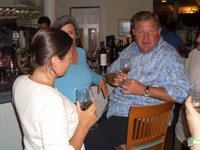
After our dinner at Quintessa, not to mention our long day of tasting and eating, our busses dropped us off at our resort and a few of us headed up to the bar for a night cap. Our group as a whole was varied and humorous, and this night one larger than life Texan (Ralph, Bottom) accompanied us into the Sommelier's Den to select our late evening's fare. He was as loud and boisterous as he was generous, and as we looked through the Reserve List, he chose some of the great rock crushers of Napa. I, meanwhile, struck a conversation with two young ladies celebrating their 21st birthdays with their mothers by visiting Napa to learn about wine. Always a sucker for educating neophytes on my passion for wine, we began tasting the wines that "the Big Guy" sent our way. Starting with three wines from winemaker Mark Herold, we began our foray: 2003 Bucella Cab (95 RP), 2003 Harris Estate Trevas Vineyard Cab, and 2003 Merus Cab (94 RP). This horizontal was merely a jumping off point for the ladies as they learned the intricacies of See, Swirl, Smell, Sip, and Savor. Their mothers watched as the eager learners began to open the door to fine tasting. We did not stop there. As Ralph got more interested in the list, we rolled out a 1999 Grace Cabernet, 1987 Phelps Eisele Vineyard Cab, and Oh I almost forgot... a 2002 Screaming Eagle (99 RP). For those of you unfamiliar, Screaming Eagle is arguably one of Napa's top cult wines, pricing out around one thousand bucks a bottle, and certainly nothing that I had ever had before. For the record, you could blind taste me today, and I could not tell the Screaming Eagle from any of the rest, but I had been drinking great wines for about 16 hours at that point. But, as the man says: "We do it for the stories we can tell". I do recall loving it, and I also know the girls knew by the end how much different that quality wines taste. So picture your 21st birthday, who you were with, and what you were drinking, and imagine the stories that Alex and Emily will be telling to their friends and children about the night they met "The Big Guy" and Da Mayor.
Friday's Photos
Sunday, June 18, 2006
Friday's Finale
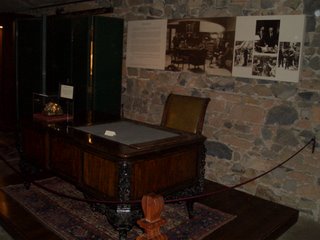
The rest of our Friday was spent tasting the efforts of Cakebread (including lunch) and then on to Francis Ford Coppola's Rubicon, formerly Niebaum-Coppola. Each provided different styles of taste pairings, with a Master Cheese Monger hosting us at Rubicon. Many of the props and Oscars from Coppola's movies were available for viewing at the museum at Rubicon, including the office desk from The Godfather movies(right).
Our evening meal was special. We were treated to a tour and dinner at Quintessa, a 285 acre gem owned by Chilean immigrant Augustin Huneeus and his wife Valeria, who also own Veramonte Winery in Chile. We were led through the vineyards, literally, to an Island in the middle of a lake among the grapes. The island's soul purpose now is entertaining, and we were met by glasses of sparkling wine and a short chat with out hosts. Again the passion for the area was foremost, with Valeria espousing her philosophy as "stewards of the land". She and Augustin had agreed to this dinner engagement no doubt months prior, with the intent of hosting us in their new home. Construction delays being what they are, we enjoyed our dinner with them on the veranda of a house in which they were to sleep for the first time that evening! Literally the sod had been placed that afternoon, and the Air Conditioning units had been wired early that morning, blowing the entire house's circuit breakers. At that point, Augustin told us, he left, returning at the time of the party, not knowing where or whether we would be eating! Our other great coincidence of the evening was that earlier that day, the winery had deemed the 2003 Quintessa ready to release. So we had the added pleasure of enjoying it in it's inaugural appearance. Three wines were served at dinner, all grown on the property. A sauvignon blanc, grown on a half acre plot on the property only for the family's consumption, Faust, a new second label effort available at Fleming's as well as Osaka in Richmond, and the newly released flagship Quintessa. Cooking our dinner while the hosts regaled us with stories of their lives, including the fleeing the Pinochet regime in Chile in the '70s, was Russell Skall, Fleming's Head Chef and Food Director for the chain.
Quintessa takes it's name from the theory that all worldly goods are made from the four elements: earth, fire, air and water. The fifth element, or quintessential, was saved for the consumption of the gods, or at least until now! The flagship wine is made from the top twenty percent of the grapes harvested from Quintessa, and the next thirty percent go into Faust. The remaining harvest is sold off to the local winemakers who need excellent grapes to add to their blends. Quintessa allowed us to purchase a case each of their reds, so perhaps next time you visit the Mayoral Cellar, you can help us compare them.
Friday, June 16, 2006
Food and Wine Pairing Class
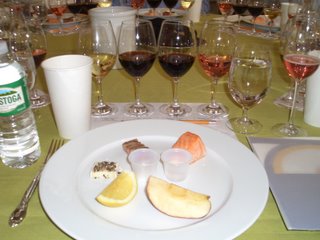
Friday morning of the Napa Experience, I found myself sipping a Sparkling Brut at 9 AM. This was to be our longest day of tasting and swilling wines, and we began at Beringer. Beringer is a large production winery with numerous labels and quality levels. We all know about the Beringer White Zinfandel, the wine made from "no such grape". But they have a number of high end wines, some of which are on the Fleming's Wine List. Their Knight's Valley Cabernet is a wonderful effort if you get a chance. Today our effort was all about pairing wines with food and our lecturer was Jerry Comfort, a former chef and current partner in a Wine Education company that Beringer started.
Jerry's lesson revolved around the theory that food changes wine, wine does not change food. Our simplest lesson tested the effect of sweet and sour on 4 different wines. Armed with an apple slice and a wedge of lemon, we tasted four styles of wine: off dry (the White Zin), crisp white with no oak (sauvignon blanc), light intensity red with little tannin (Pinot Noir) and a strong intensity red with tannin (Cabernet Knights Valley). Each was affected in similar ways by the various outside tastes. After the sweet apple, each wine became more acidic or tart, and the Cabs tannins became more bitter and astringent. Even the White Zin lost all elements of sweetness. The lemon had the opposite affect, neutralizing the acid in the wines. The sweetness became cloying, and the reds became flabby, with no element of structure or mouth feel. We did a similar test with a piece of pepper coated Brie, simulating spicy foods. Typically we recommend wines with some residual sugar to pair with spicy foods (think Gewurtztraminer). The White Zin performed that role in this tasting, and the structure of the spice remained. When we tried the tannic Cabernet however, the oak accentuated the spice, and the taste of the fruit is diminished in the wine. The result is a very hot mouth feel and increased spice. Not a pleasant pairing. However when we seasoned the spicy food with lemon and salt, two typical additions, the resulting reaction helps reduce the spice, and works with the oak to "fix" the wine, and the flavor of the wine returns, and spice is modified. The subsequent pairings involved this theory. Various foods were "seasoned" with moderate levels of acid and salt, and the resulting pairing typically was a winner. The conclusion was that most wines pair with most foods, if the competing elements are neutralized with proper seasoning. This is most effectively shown when we add salt and lime to tequila! The Margarita demonstrates how the acid and salt neutralize the bitterness of the tequila and maximize the sweetness of the Lime and Agave. For homework, let me recommend you try a light white and a heavy red with a piece of Salmon, unseasoned. Watch the food affect the wines, the red especially becoming more oily tasting and overpowering the fish. Then add a bit of lemon and salt to the salmon. The result is a balance of flavors in the wine, and regardless of how big a red or light a white you use, they tend to work.
Monday, June 12, 2006
Patience My Followers
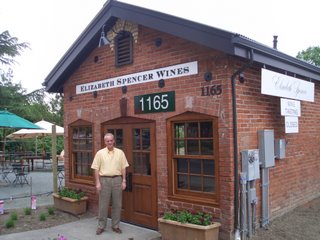
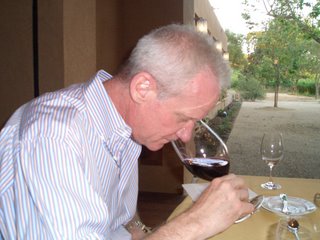
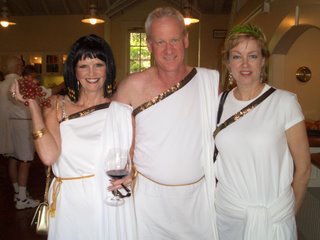
Pictures From Top: I stumble across Elizabeth Spencer; Tasting the 2003 Quintessa, released on the day we arrived; Your Mayor Joins Fleming's Wine Director Marian Jansen op da Haar (right) and Aphrodite for the Toga Party.
As you can imagine, my sensory overload slowed my writing down to a crawl once the wine began to flow and images and food became indelibly linked. I'll begin to transcribe my notes over the next few days, and try to create for you the tapestry of sights and sounds and smells and tastes that I was lucky enough to experience at the hand's of the professional Fleming's crew. Napa is a gem of a place, but more than that, it is a group of passionate, off beat personalities who, for the good of the Napa product, band together and create magic on so many levels. Enjoy a few photos while you patiently wait for the stories in my heart to be decanted, swirled, sipped and savored.
Friday, June 09, 2006
Casa Paul Fleming
After a leisurely day at the Claremont in Berkeley in Oakland, I was whisked away to Napa and the Meadowood Resort. After settling into my room, a private nook about a driver and a pitching wedge away from the main building, I met up with my group for the weekend at a reception in the resort's lobby. It's a bustling group of energetic couples, from a well rounded cross section of the country, from Naples and the DC area all the way to San Jose, a mere 2 hour drive away. We introduced ourselves and met with Marion, the Fleming's Director of Wine for the whole chain. She was a delightful Dutch blond, with an easy charm and quick smile. She asked us to tell of our hometown and favorite wine, and I once again realized how "New World centric" this group was likely to be. But that's to be expected. So we boarded busses and headed off to meet the creator of the Fleming's concept, Paul Fleming and his pretty wife Kelly. A simple but elegant ranch cut into the top of a hill overlooking the Napa River, Kelly designed this beautiful home understanding the biggest threat to the valley: Fire. Stone and wrought iron, there is no exterior maintenance, and nothing to burn in the tragic case of destruction of the area. She said it was her intent to be able to move right back in after any tragedy. She grows five acres of Cabernet, and countless small gardens of organic vegetables and herbs. Paul handled the initial greeting and passed out our first wines. He is a mid fifties boyish looking power player with a passion for value and service. From the moment we shook hands I felt an easy friendship, and enjoyed listening to his methodology of creativity in designing his restaurant visions.
The outside veranda was set up with two long tables set for forty of us, and as we enjoyed the first offering of Rose brut and Sauvignon Blanc, we tasted grilled sardines wrapped in grape leaves, and skewered salmon appetizers. Bisecting the two long dining tables was a water feature, a foot wide and foot deep stream going from the house to the edge of the veranda, where it cascaded down the hill in front of us not dissimilar to some of the Inca aqueducts that BW and I see in Peru. We took bets the rest of the night as to who was going to be stepping into this water hazard, perfectly situated for drunken wine guzzlers to disregard on their way to and from the tables.
The dinner call came with no one's feet wet however and we sat in the setting sun to enjoy the Fleming's hospitality. A Fava bean soup was first served with Etude Pinot Noir fromCarneros. The chef for the evening it turns out used to work at Chez Panisse, and still sells the organic goods from the her own garden to the restaurant. So on successive evenings, I enjoyed fava from her garden prepared in slightly different ways. Small world. This soup was broth based with spring onion and topped with sage flowers and arugula blossoms. Whole fava, not dissimilar to lima beans, brought an earthy depth to the dish, complimenting the wine style.
Our main course was sliced loin of beef with small onions and potatoes with crispy fried green and an almond onion sauce. One of the greens was small sage leaves, fired crisp and salted and dusted with an ever so slight portion of cheese crumbs. I took some notes on this interesting Kelly's 2002 Cabernet was brought out for this course, a three hundred case effort which has smoothed we were told and emerged from a bit of a dumb stage to present quiet fruit with mild tannin, not a rock crusher but more in a Sonoma, cooler climate, style. The Fleming's crew, Paul and Kelly included moved around the two tables, sitting in different places for each course, and encouraging the guests to do the same. Our table, made our move to uproot about half the folks at table two after the steak and before our third course, a salad green and cheese pairing. This brought uproar and chaos, but that was it's intent, and we settled in to meet and greet new faces. One poor girl, Sally, had been thrust between two couples from Southern California who traveled together. Their teasing had gotten her laughing at literally every thing they said, to the crying, belly hurting laugh point. So easy was she to be put off on another tear of laughter, one of the couples wives held up the butter dish and yelled out: "Hey, Sally! Butter!" To which Sally once again was doubled over in pain and tears of mirth.
After the salad, Taylor Fladgate 1988 vintage Port was poured all round, and a strawberry tart brought to continue the similarities between my two California dinners. Darkness had fallen and the air had cooled by this time, and the host couple moved around and between their guests having photos taken, and telling us about his future endeavors. Paul is a consummate restauranteur and business man, a pleasant professional. His home and family show his grace and quality and as we rode back to our hotel, I could not help thinking how nice it will be to return to visit them again.
The outside veranda was set up with two long tables set for forty of us, and as we enjoyed the first offering of Rose brut and Sauvignon Blanc, we tasted grilled sardines wrapped in grape leaves, and skewered salmon appetizers. Bisecting the two long dining tables was a water feature, a foot wide and foot deep stream going from the house to the edge of the veranda, where it cascaded down the hill in front of us not dissimilar to some of the Inca aqueducts that BW and I see in Peru. We took bets the rest of the night as to who was going to be stepping into this water hazard, perfectly situated for drunken wine guzzlers to disregard on their way to and from the tables.
The dinner call came with no one's feet wet however and we sat in the setting sun to enjoy the Fleming's hospitality. A Fava bean soup was first served with Etude Pinot Noir fromCarneros. The chef for the evening it turns out used to work at Chez Panisse, and still sells the organic goods from the her own garden to the restaurant. So on successive evenings, I enjoyed fava from her garden prepared in slightly different ways. Small world. This soup was broth based with spring onion and topped with sage flowers and arugula blossoms. Whole fava, not dissimilar to lima beans, brought an earthy depth to the dish, complimenting the wine style.
Our main course was sliced loin of beef with small onions and potatoes with crispy fried green and an almond onion sauce. One of the greens was small sage leaves, fired crisp and salted and dusted with an ever so slight portion of cheese crumbs. I took some notes on this interesting Kelly's 2002 Cabernet was brought out for this course, a three hundred case effort which has smoothed we were told and emerged from a bit of a dumb stage to present quiet fruit with mild tannin, not a rock crusher but more in a Sonoma, cooler climate, style. The Fleming's crew, Paul and Kelly included moved around the two tables, sitting in different places for each course, and encouraging the guests to do the same. Our table, made our move to uproot about half the folks at table two after the steak and before our third course, a salad green and cheese pairing. This brought uproar and chaos, but that was it's intent, and we settled in to meet and greet new faces. One poor girl, Sally, had been thrust between two couples from Southern California who traveled together. Their teasing had gotten her laughing at literally every thing they said, to the crying, belly hurting laugh point. So easy was she to be put off on another tear of laughter, one of the couples wives held up the butter dish and yelled out: "Hey, Sally! Butter!" To which Sally once again was doubled over in pain and tears of mirth.
After the salad, Taylor Fladgate 1988 vintage Port was poured all round, and a strawberry tart brought to continue the similarities between my two California dinners. Darkness had fallen and the air had cooled by this time, and the host couple moved around and between their guests having photos taken, and telling us about his future endeavors. Paul is a consummate restauranteur and business man, a pleasant professional. His home and family show his grace and quality and as we rode back to our hotel, I could not help thinking how nice it will be to return to visit them again.
Thursday, June 08, 2006
Night 1 - The California Swing Begins
Arrived safely in Oakland after a nice day for flying across this great country. A couple hour layover in Dallas yielded a great new Mexican restaurant over in Terminal D, where I slugged down the requisite margarita with my Chimichunga. Cabbed to the Claremont in Berkeley where my room was not quite ready but allowed me the opportunity to try a nice California Sauvignon Blanc on the terrace looking overlooking the Bay toward San Fran and the Golden Gate Bridge.
Dinner was scheduled for 6:30 at Chez Panisse. Grabbed a cab about 6, and wove through the UC - Berkeley Campus, which is lovely and great for people watching. My friends Brad and Roger ran a bit late due to traffic but I took the time to browse through the latest copy of "The Onion", a sarcastic newspaper with some great humor and observation. As I waited in the trendy restaurant, I ordered a glass of rose Bandol from France, dry and crisp with just the right acid to match the olive snack placed on the table. I knew this was not going to be a week of much old world wine, so I was going to try to sneak them in whenever I could. Plus it's always fun to watch people's reaction when you have a pink wine on the table. Little do they know...
When the boys arrived, we got down to business, beginning with Roger's choice, a Littorai Thierot Vineyard Chardonnay. This gem was made in the classic tradition of Burgundy, so came across like on of the great Chablis premier crus. Crisp and well balanced with a little toast and wonderful mineral flavors that the North Coast of California is able to impart, if the winemakers will allow it to emerge. Our food pairings for this wine began with a warm shrimp salad with basil and scallions. Always the hardest wine pairing course because if the vinegar, this salad was light and fresh with that great mouth feel of warm/cool of the shrimp and local greens. A nice balance was provided by the chardonnay in that the vinegar was merely hinted in the dressing.
Next two soups, a fava bean puree and carrot with tarragon cream were combined in one bowl, the colors dividing in half like a more straight line Ying Yang symbol. We all noted how the carrot seemed so fresh that there was none of the cloying sweetness that seems to pervade carrot dishes and the hint of tarragon brought the wines more aromatic nuances out. The fava bean side was, in quoting Roger: "Fava Bean". Kind of bland, but I pulled out what was left of my French Bandol, and VOILA, the slight earthiness of the dry rose was a much better pairing, bringing out the earthy note of the bean. Score one for the old world again.
Brad brought along a '96 Burgess Family Barossa Shiraz, 95 points from Mr. Parker, and we now poured that for the main course. I think we were all concerned about the rock crusher Aussie style conflicting with the next offering, a chicken ballotine and breast with wild mushrooms, spinach and asparagus. However we were all pleasantly amazed with the smooth velvet that poured across our palates. Classic nose of white and black pepper, but none of the astringent tannins which can overwhelm a younger Shiraz. And the gamey free range flavors of the chicken stepped up the flavor, and helping to match the rural notes of the mushrooms and the earthiness evident in the wine.
Not ready to rush to dessert, we ordered an interim syrah for a compare and contrast exercise. They allowed me one more shot at the old world, and I opted for a half bottle Yann Chave Crozes Hermitage. What a powerful counternote to the Shiraz. Warm and earthy with the nuances I love in French wines, we all enjoyed this classic maker's offering, where the fruit and oakiness balanced and made for a mouth full of heaven.
I was also allowed to pair the dessert, a strawberry-almond tartlet, with a sweet final sip. The "almond" in the description made my eyes cast to a Hungarian Tokaji, a nutty sweet wine measured in quality and sweetness by its level of "puttonyos", a one to six scale. The Oremus Five Puttonyos matched up with the dessert and was a new wine taste to my two friends. Those who know me well, recall the influences that a good friend of Hungarian descent had on my food and wine enjoyment in stories past, so this was a predictable choice. Now all we needed was the Zwack Unicum to use as a digestif!
Good friends, old or new, and good food in a festive setting always yield good stories.
Chez Panisse is a stellar example of what great chefs do with fresh, organic local ingredients, in this case, relationships cultivated by Chef Alice Waters since this restaurant opened in 1971. It's a "Must Visit" in the Bay area, not because of showy hugeness so popular today, but for it's value (dinner was $65 prix fixe), it's diminutive size and tasteful ambiance, and above all it's talented staff.
More tomorrow as I join the Fleming's crowd for our Napa Experience!
Dinner was scheduled for 6:30 at Chez Panisse. Grabbed a cab about 6, and wove through the UC - Berkeley Campus, which is lovely and great for people watching. My friends Brad and Roger ran a bit late due to traffic but I took the time to browse through the latest copy of "The Onion", a sarcastic newspaper with some great humor and observation. As I waited in the trendy restaurant, I ordered a glass of rose Bandol from France, dry and crisp with just the right acid to match the olive snack placed on the table. I knew this was not going to be a week of much old world wine, so I was going to try to sneak them in whenever I could. Plus it's always fun to watch people's reaction when you have a pink wine on the table. Little do they know...
When the boys arrived, we got down to business, beginning with Roger's choice, a Littorai Thierot Vineyard Chardonnay. This gem was made in the classic tradition of Burgundy, so came across like on of the great Chablis premier crus. Crisp and well balanced with a little toast and wonderful mineral flavors that the North Coast of California is able to impart, if the winemakers will allow it to emerge. Our food pairings for this wine began with a warm shrimp salad with basil and scallions. Always the hardest wine pairing course because if the vinegar, this salad was light and fresh with that great mouth feel of warm/cool of the shrimp and local greens. A nice balance was provided by the chardonnay in that the vinegar was merely hinted in the dressing.
Next two soups, a fava bean puree and carrot with tarragon cream were combined in one bowl, the colors dividing in half like a more straight line Ying Yang symbol. We all noted how the carrot seemed so fresh that there was none of the cloying sweetness that seems to pervade carrot dishes and the hint of tarragon brought the wines more aromatic nuances out. The fava bean side was, in quoting Roger: "Fava Bean". Kind of bland, but I pulled out what was left of my French Bandol, and VOILA, the slight earthiness of the dry rose was a much better pairing, bringing out the earthy note of the bean. Score one for the old world again.
Brad brought along a '96 Burgess Family Barossa Shiraz, 95 points from Mr. Parker, and we now poured that for the main course. I think we were all concerned about the rock crusher Aussie style conflicting with the next offering, a chicken ballotine and breast with wild mushrooms, spinach and asparagus. However we were all pleasantly amazed with the smooth velvet that poured across our palates. Classic nose of white and black pepper, but none of the astringent tannins which can overwhelm a younger Shiraz. And the gamey free range flavors of the chicken stepped up the flavor, and helping to match the rural notes of the mushrooms and the earthiness evident in the wine.
Not ready to rush to dessert, we ordered an interim syrah for a compare and contrast exercise. They allowed me one more shot at the old world, and I opted for a half bottle Yann Chave Crozes Hermitage. What a powerful counternote to the Shiraz. Warm and earthy with the nuances I love in French wines, we all enjoyed this classic maker's offering, where the fruit and oakiness balanced and made for a mouth full of heaven.
I was also allowed to pair the dessert, a strawberry-almond tartlet, with a sweet final sip. The "almond" in the description made my eyes cast to a Hungarian Tokaji, a nutty sweet wine measured in quality and sweetness by its level of "puttonyos", a one to six scale. The Oremus Five Puttonyos matched up with the dessert and was a new wine taste to my two friends. Those who know me well, recall the influences that a good friend of Hungarian descent had on my food and wine enjoyment in stories past, so this was a predictable choice. Now all we needed was the Zwack Unicum to use as a digestif!
Good friends, old or new, and good food in a festive setting always yield good stories.
Chez Panisse is a stellar example of what great chefs do with fresh, organic local ingredients, in this case, relationships cultivated by Chef Alice Waters since this restaurant opened in 1971. It's a "Must Visit" in the Bay area, not because of showy hugeness so popular today, but for it's value (dinner was $65 prix fixe), it's diminutive size and tasteful ambiance, and above all it's talented staff.
More tomorrow as I join the Fleming's crowd for our Napa Experience!
Tuesday, June 06, 2006
Monday, June 05, 2006
Sunday Wine Tasting June 4th
Our Sunday Wine Tasting Series kicked off last night with a blend of old and new, both in wines, and in wine cellar visitors. These are informal wine and cheese quaffs in which I pick some cellar gems, attempt to pair them with some neat cheeses, and lead a discussion on the relative merits of both the wines and the pairings. Lasting about an hour and a half, I always describe these as "Come enjoy my hospitality from 5:30 until 7:00, and then get the hell out of my house".
It's always fun to gather an eclectic crowd and last night was no exception. Three lovely ladies from a women's wine group who have become great fans of the cellar and good friends were the first to sign up. An old workplace chum who has moved on to another job joined in as well. And Barbara, who starred in the Spanish tasting notes from the Bin22 event, and the photo therefrom, brought the boyfriend of one of the other ladies from that evening. We were rounded out with my chemist friend Chris, who added a scientific side to the discussions. We started with a white, a small production Marsanne/Ugni Blanc/Grenache Gris blend from Australia. All combined, they produced a pleasantly acidic lightly fruited warm weather quaff not dissimilar from Sauvignon Blanc. More lemon than grapefruit, and some of us picked out the "bitter almond" on the nose that our downloaded tasting notes told us to look for. The cheeses (a soft Camembert, my favorite Petit Basque, and an Aged Gouda) mellowed the acid (always look for this to happen) but also clouded any complexity that the wine had. For the most part, it was seen as a stand-alone summer sipper, before moving on to more exciting offerings.
We moved to the old world next with a value priced 1998 Barolo from Lodali. Light color, edged in brick, reminiscent of Pinot Noir, with all the earthy notes that denote Barolo, this wine also showed it's acid and abundance of dark red fruits and blackberry. Slight toast and tobacco, it paired nicely with our cheeses and grapes, a characteristic generally expected form the old world style. This wine opened dramatically with three hours of decanting.
Next we were blessed by the magnanimous BW who allowed us to open one of her Peruvian wines, a 2002 Tannat-based Tacama. This wine had become flawed, but not so much that we could put our finger on it. Only after arguing it's relative merits and idiosyncrasies, did Bobbie come in and taste it and pronounce it shot. We opened another bottle from a different vintage, and got all the appropriate red fruits and color of the varietal that we expected. Not expensive, it is typical of the efforts from central South America. Worth a try for the education of palate, look for locally from Uruguay.
We finished the evening in Bordeaux, as those of you who know me might expect. Chateau Cantenac Brown 1998 is a Margaux based wine, blending the typical Cab/Merlot/ Cab Franc. Earthy and solid, the nose foretold of it's style. Deep aromas of the dark fruits and bell pepper. The taste was typical of the region: Dark fruit, wonderful earth moderate tannins that faded after decanting. The cheeses and this wine are made for each other, and the relative lower acid level in the wine allowed more of the flavor of the cheese to shine. Acid tends to blend with the fats in cheeses to mute each other out, sometimes necessary, but sometimes to the detriment of both.
We went back and tasted through the wines again and I always notice in that review that some earlier also-rans rise up and become favorites. Always keep a little bit of the wines tasted early on so that they may get the benefit of your softened palate later. The change is amazing. All in all, a successful effort and interesting discussion among new and old friends. And they were all "the hell out of my house" by 7!
It's always fun to gather an eclectic crowd and last night was no exception. Three lovely ladies from a women's wine group who have become great fans of the cellar and good friends were the first to sign up. An old workplace chum who has moved on to another job joined in as well. And Barbara, who starred in the Spanish tasting notes from the Bin22 event, and the photo therefrom, brought the boyfriend of one of the other ladies from that evening. We were rounded out with my chemist friend Chris, who added a scientific side to the discussions. We started with a white, a small production Marsanne/Ugni Blanc/Grenache Gris blend from Australia. All combined, they produced a pleasantly acidic lightly fruited warm weather quaff not dissimilar from Sauvignon Blanc. More lemon than grapefruit, and some of us picked out the "bitter almond" on the nose that our downloaded tasting notes told us to look for. The cheeses (a soft Camembert, my favorite Petit Basque, and an Aged Gouda) mellowed the acid (always look for this to happen) but also clouded any complexity that the wine had. For the most part, it was seen as a stand-alone summer sipper, before moving on to more exciting offerings.
We moved to the old world next with a value priced 1998 Barolo from Lodali. Light color, edged in brick, reminiscent of Pinot Noir, with all the earthy notes that denote Barolo, this wine also showed it's acid and abundance of dark red fruits and blackberry. Slight toast and tobacco, it paired nicely with our cheeses and grapes, a characteristic generally expected form the old world style. This wine opened dramatically with three hours of decanting.
Next we were blessed by the magnanimous BW who allowed us to open one of her Peruvian wines, a 2002 Tannat-based Tacama. This wine had become flawed, but not so much that we could put our finger on it. Only after arguing it's relative merits and idiosyncrasies, did Bobbie come in and taste it and pronounce it shot. We opened another bottle from a different vintage, and got all the appropriate red fruits and color of the varietal that we expected. Not expensive, it is typical of the efforts from central South America. Worth a try for the education of palate, look for locally from Uruguay.
We finished the evening in Bordeaux, as those of you who know me might expect. Chateau Cantenac Brown 1998 is a Margaux based wine, blending the typical Cab/Merlot/ Cab Franc. Earthy and solid, the nose foretold of it's style. Deep aromas of the dark fruits and bell pepper. The taste was typical of the region: Dark fruit, wonderful earth moderate tannins that faded after decanting. The cheeses and this wine are made for each other, and the relative lower acid level in the wine allowed more of the flavor of the cheese to shine. Acid tends to blend with the fats in cheeses to mute each other out, sometimes necessary, but sometimes to the detriment of both.
We went back and tasted through the wines again and I always notice in that review that some earlier also-rans rise up and become favorites. Always keep a little bit of the wines tasted early on so that they may get the benefit of your softened palate later. The change is amazing. All in all, a successful effort and interesting discussion among new and old friends. And they were all "the hell out of my house" by 7!
Sunday, May 28, 2006
Fleming's Napa Wine Experience

Next week I head out to Napa for a long weekend sponsored by Fleming's for their Magnum Club Members. As the only Richmonder to jump on this opportunity, I will be alongside 29 other good customers from all around the country where Fleming's has locations. I arrive a day early to meet up with friends from San Francisco and join them for dinner in Berkeley at Chez Panisse, considered one of the Bay areas finest restaurants. The host resort for the weekend is Meadowood, pictured above. A full service spa and resort located in the heart of Napa Valley, this awsome site has played host to the burgeoning wine industry in Napa since 1964. For the last twenty five years, it has been the preeminent destination for discerning travelers visiting the region. Thursday evening begins the Napa Wine Experience with dinner at Paul Fleming's home in Calistoga, overlooking the Russian River. The highlight of the evening is the unveiling of his wife Kelly's first release of Cabernet Sauvignon.
Friday is a grueling day of tasting and touring, beginning at Beringer, where we have a tour and wine and food pairing class. Cakebread hosts our luncheon, and a class on blending wine from barrels with Dennis Cakebread, the owner. Our afternoon is a private tour and tasting at Francis Ford Coppola's historic Niebaum-Coppola winery. Friday evening, we are off to Quintessa, where we enjoy a reception and four course dinner prepared by the Fleming's Executive Chef Russel Skall at the residence constructed on the "Island of Quintessa".
Saturday we are off to a morning tour at Honig winery with the owner and a discussion of organic techniques in winemaking. Then across the vineyard we will walk to Frog's Leap for our tour and discuss the "biodynamic" farming techniques, followed by lunch the their "Ghost Winery". An afternoon off is well deserved and I plan to take time out for a Grape Seed Body rub, and facial. If I wake up, I rejoin the crew for our theme dinner and toga party at the Franciscan Oakville Estate.
Sunday morning is a champagne brunch at Gloria Ferrar and departure back to reality and my cross country flight home. I'll take lots of photos, and post them, and I'll be sure to keep my notes safe so that I can write the story of the trip. Looking forward to sharing this with all of you!
Saturday, May 27, 2006
Recent Tasting Photos From the Cellar
Wednesday, May 24, 2006
Latest List of Tastings
Cafe Gutenburg WineDown Wednesdays, half price wine by the glass 5-10 pm. 17th and Main. www.cafegutenberg.com
Can Can, Monday tastings 6-7 $1. Wine Dinners Wednesdays, Reservations required. (Carytown) 358-7274 www.cancanbrasserie.com
Wine Lovers Thursdays 530-7 Free. John Rolfe Parkway
Beer and Wine Westpark Thursdays 4-7 Free. Broad St. beyond Parham
Melting Pot Thursdays 6:30 Tasting and discussion $10. Gaskins Near Gayton
The Wine Cellar Fridays 5-8 Free. Huguenot at Midlothian
River City Cellars Fridays 5-7 Free. Carytown
http://www.rivercitycellars.com/
Bin 22 Wine flights with light foods and cheeses. Tuesday thru Saturday. Carytown
Fleming's First Monday of each month 5:30-7:00 Free. Charity Wine Wednesdays 3rd Wednesday of each month. Reduced priced glasses, all proceeds to charity. May 17, 6:00-8:00 Stony Point Fashion Mall
http://www.flemingssteakhouse.com/
Can Can, Monday tastings 6-7 $1. Wine Dinners Wednesdays, Reservations required. (Carytown) 358-7274 www.cancanbrasserie.com
Wine Lovers Thursdays 530-7 Free. John Rolfe Parkway
Beer and Wine Westpark Thursdays 4-7 Free. Broad St. beyond Parham
Melting Pot Thursdays 6:30 Tasting and discussion $10. Gaskins Near Gayton
The Wine Cellar Fridays 5-8 Free. Huguenot at Midlothian
River City Cellars Fridays 5-7 Free. Carytown
http://www.rivercitycellars.com/
Bin 22 Wine flights with light foods and cheeses. Tuesday thru Saturday. Carytown
Fleming's First Monday of each month 5:30-7:00 Free. Charity Wine Wednesdays 3rd Wednesday of each month. Reduced priced glasses, all proceeds to charity. May 17, 6:00-8:00 Stony Point Fashion Mall
http://www.flemingssteakhouse.com/
Second Label Find of the Week
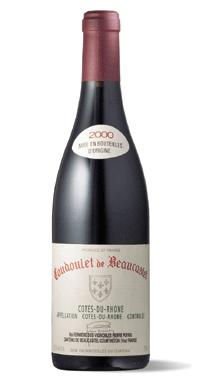
Many good wineries whose offerings are too expensive for the typical pocketbook put out “Second Label “ wines. Generally, these are from grapes that didn’t make the first cut for quality, or are blended with grapes from outside the premier wine’s region. Most of the classified chateaux in Bordeaux bottle a second label, as do the big guns of Napa. Opus One only sells it’s second label , called Overture, at the winery. At about $40, that’s about one fourth the cost of the premier label. Still not cheap, but for the incremental decrease in quality, it’s a bargain.
This week, I stumbled onto the second label from Chateau de Beaucastel, a premium make in the Southern Rhone of France. The premium wine is a Chateauneuf du Pape, and is routinely one of the better, and more costly wines of the region. Second label Coudoulet de Beaucastel is a Cotes-du-Rhone, required because some of the grapes are purchased and are from outside of the Chateauneuf region. Parker weighed in at 89 points for this 2003 effort, and promised that the 2004 would exceed that. My notes include wonderful dark cherry, tar and a dense mouth feel. I picture this with something gamey, duck or even rabbit, slow cooked and with a fruit demi-glace. The long finish tells of it’s quality, and the herbs and spices on the nose deliver differing nuances to each sip.
Carytown Wine and Beer stocks this at $33, and for a nice dinner or other special occasion, you might grab a bottle of this and enjoy what the “Old World” does best.
Friday, May 19, 2006
Big Brother Hits Wine Corks
New technology is being used now to track a myriad of information about individual bottles of wine. A microchip is now available to be placed into the synthetic cork of a wine which will send, receive and hold pages of data about the wine inside. An Italian designer has created this RFID cork insert and labeling technology, called SmartCorq, and Arnaldo Caprai is using it on his new Comtemporare Sangiovese. By utilizing radio frequency identification (RFID) technology, a wine's provenance, harvest information, flavor profiles and even suggested food pairings can be inscribed on a rice-sized chip that resides inside the cork. The reader will likely be available at retail stores and various other outlets. Costing about $140 a piece , the reader will not likely be for most consumers to purchase.
Another likely use will be to combat fraud at wine auctions where mislabeling can make a cheap wines sell for many times their value, masking them as expensive collectibles. Collectors will be able to know provenance, temperature extremes and other data that will increase the value of properly handles wines, and exposing poorly handled wines for what they are.
Besides Caprai in Italy, Gallo in the US has been testing RFID since 2004. Many large retailers use pallet attached RFID’s to track loads of many types of product outside of the wine industry. Walmart is a retail industry leader at this time. But in the wine trade, most are waiting to see what the large wineries do. As more and more advantages appear, and the technology becomes affordable., look for more chips to be installed and more data to become available to the consumer.
Another likely use will be to combat fraud at wine auctions where mislabeling can make a cheap wines sell for many times their value, masking them as expensive collectibles. Collectors will be able to know provenance, temperature extremes and other data that will increase the value of properly handles wines, and exposing poorly handled wines for what they are.
Besides Caprai in Italy, Gallo in the US has been testing RFID since 2004. Many large retailers use pallet attached RFID’s to track loads of many types of product outside of the wine industry. Walmart is a retail industry leader at this time. But in the wine trade, most are waiting to see what the large wineries do. As more and more advantages appear, and the technology becomes affordable., look for more chips to be installed and more data to become available to the consumer.
Sunday, May 14, 2006
Graduation Toast
As I read the various Commencement and Graduation speeches in the paper, it seems to me a proper time to note how much younger the wine drinking public seems to be these days. There's a shift toward wine, certainly from harder alcohol, and to a lesser but still noticeable extent, from beer. And the young drinkers are savvy. Sauvignon Blancs and Gruner Veltliners are replacing Pinot Grigios and the range of reds from all over the world seem to surplant the Merlot request we became tired of hearing. It follows the symbolism of graduation. Our young friends are moving away from the comfortable surroundings, whether by hook or crook, and embracing trying the new exciting world that is out in front of them. New venues replace the college bar and good food replaces cafeteria fare. As they open themselves up to these new experiences, new cities, and new careers, remember to support their new habits, welcome them into what we laughingly call adulthood, and raise a toast to our new wine loving friends. Congratulations Graduates! You have worked hard, and we are so proud of you.
Unfiltered and Unfined
Filtering wines of their impurities prior to bottling is a technique steeped in controversy. Many good winemakers feel that this process, actually passing the wine through a membranous filter, not only removes the particulate matter, but invariably some of the nuance or character of the wine. Filtering leaves the wine crystal clear with little sediment. “Fining” is a different technique in which an agent, like activated charcoal or even egg white, is dropped into the wine and as it sinks to the bottom, collects the microscopic particles that can cloud the wine. This method also can be used to remove color from white wines or even flawed odors. Once the fining agent sinks to the bottom, the wine is “racked” to skim off the top clean wine. Racking involves siphoning the wine from the top into a new vessel, leaving the bottom impurities in the original cask. Racking can be used in conjunction with filtering and fining, or by itself to remove any particulate matter which may cloud the wine. Winemakers are typically vehement in their selected method, and often list their choice on the label. Wines listed as “unfiltered and unfined” use racking or other “natural” methods to remove particles without losing the ultimate character of the wine. Do not be surprised to find small bits of sediment in red wines listed this way. My personal experience is that these wines carry with them the body and structure that I enjoy in a wine, at the expense of complete clarity that another may prefer. Smile when you see a little sediment. All the goodness that the wine gods intended have been left in the wine for your enjoyment.
Thursday, May 11, 2006
Technical Glitch
Hey my good readers and friends. Due to a technical glitch (read: Screw up by me), only people with blogs on this server were permitted to post comments to my blog. MY BAD.
Now you may comment to each article as I write it. Sorry for the unprofessional set up, but now it works. Thanks for keeping your comments clean, but do comment.
Da Mayor
Now you may comment to each article as I write it. Sorry for the unprofessional set up, but now it works. Thanks for keeping your comments clean, but do comment.
Da Mayor
Saturday, May 06, 2006
Barbara uses the Porron
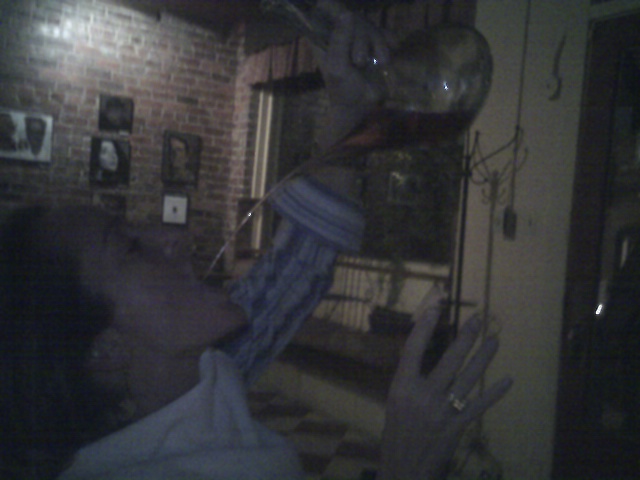
Careful! Notice that the wine we were tasting here is the "Rosado" which was one of the Cavas, a sparkling wine. Barbara spilled nary a drop, owing to her her awesome hand/eye coordination, and great desire for the free wine. While you get used to this method...I'd stick to whites!
Bin 22 Spanish Tasting
Ok, so I went to the Spanish wine tasting at Bin 22 (Carytown) on Tuesday. Greg, the proprietor, assigned my group of three to a table of six, and creating a family style tone to the evening. Six wines tasted, 2 cavas (sparkling) 2 whites, and 2 riojas (one white) with food pairings which as always at this venue punctuates the wines and shows us different old world nuances not available in a simple wine-only taste. Even a sweetish blueberry brie with the whites worked against the stainless steel acids. Our table decided that as new friends we would discuss no religion or politics, so we quickly debauched into the only subject left. Cordell was particularly over-endowed in conversational talent. With the wine still flowing and frequent visits by our tasting host from Dionysis, Chris Reynolds, we did explore the variable varietals that Spain offers. Toward the end, Greg broke out a tasting vessel, Spainish in origin we were told, shaped like a tall decanter with an additional pipette horizontally attached to the side. Called a "Porron", the idea is to pour slowly from the pipette into your mouth, and as you become comfortable with the stream, increase the distance from bottle to mouth by extending your arm. The result is typically a less than accurate aim, wet shirt, and in some cases, damp socks. On my unfateful try, the vessel became so empty, that the angle required actually allowed wine to flow out of the top, splashing onto my head to the great merriment of the collected entourage. Photos taken will be posted on the blog, grainy and unfocused as the subjects in them. Bin 22 is a gem. Experience it. But bring a raincoat.
Tasting List from the Event:
Avino Cava
Avino Cava Rosada
Gatariako Txacoli
Xarnant Txacoli
Ostatu Blanco
Arbanta Rouge
Tasting List from the Event:
Avino Cava
Avino Cava Rosada
Gatariako Txacoli
Xarnant Txacoli
Ostatu Blanco
Arbanta Rouge
Latest Tasting Venues
Cafe Gutenburg WineDown Wednesdays, half price wine by the glass 5-10 pm. 17th and Main. www.cafegutenberg.com
Can Can, Monday tastings 6-7 $1. Wine Dinners Wednesdays, Reservations required. (Carytown) 358-7274 www.cancanbrasserie.com
Wine Lovers Thursdays 530-7 Free. John Rolfe Parkway
Beer and Wine Westpark Thursdays 4-7 Free. Broad St. beyond Parham
Melting Pot Thursdays 6:30 Tasting and discussion $10. Gaskins Near GaytonThe Wine Cellar Fridays 5-8 Free. Huguenot at Midlothian
River City Cellars Fridays 5-7 Free. Carytown
http://www.rivercitycellars.com/
Bin 22 Wine flights with light foods and cheeses. Tuesday thru Saturday. Carytown
Fleming's First Monday of each month 5:30-7:00 Free. Charity Wine Wednesdays 3rd Wednesday of each month. Reduced priced glasses, all proceeds to charity. May 17, 6:00-8:00 Stony Point Fashion Mall http://www.flemingssteakhouse.com/
Can Can, Monday tastings 6-7 $1. Wine Dinners Wednesdays, Reservations required. (Carytown) 358-7274 www.cancanbrasserie.com
Wine Lovers Thursdays 530-7 Free. John Rolfe Parkway
Beer and Wine Westpark Thursdays 4-7 Free. Broad St. beyond Parham
Melting Pot Thursdays 6:30 Tasting and discussion $10. Gaskins Near GaytonThe Wine Cellar Fridays 5-8 Free. Huguenot at Midlothian
River City Cellars Fridays 5-7 Free. Carytown
http://www.rivercitycellars.com/
Bin 22 Wine flights with light foods and cheeses. Tuesday thru Saturday. Carytown
Fleming's First Monday of each month 5:30-7:00 Free. Charity Wine Wednesdays 3rd Wednesday of each month. Reduced priced glasses, all proceeds to charity. May 17, 6:00-8:00 Stony Point Fashion Mall http://www.flemingssteakhouse.com/
Saturday, April 29, 2006
Wine Things I Noticed This Week
Had a fun tasting in the Mayoral Cellar this week, and a few things come to mind to share. I have been trying to taste the Stephen Vincent Sauvignon Blanc for a long time. Have loved his Cab, and heard raves about his Chard. So I opened one for the guests as a starter wine. Don’t bother. Totally lacking in acid, or even California grassiness, this flabby effort tasted more like an oaky Pinot Grigio, and a cheap one at that. No real fruit, certainly nothing like the New Zealands. I like some vigor and balance, and got neither.
My next epiphany came tasting a Chateau Margaux from my birth year that same night. Now 1957 wasn’t the same quality year in Bordeaux that it was in Richmond, so I knew this fondly held wine was about done as far as style points go. I made this our first red since I knew it would be lighter than the ‘00 Burgundy and ‘98 St Emilion to follow. And it was...For a while. But when we revisited it after tasting the last two wines, the old gem came to life. Not because of additional air (we had opened all wines 3 hours early). Something in our mouths changed. All of us agreed that the ‘57 had the oomph to stand well beside the two younger bucks. And I have no idea why, but I’m glad we tried it. When you taste next time, keep your first wine around for another sample at the end. Watch your mouth work to make it shine a little differently.
My next epiphany came tasting a Chateau Margaux from my birth year that same night. Now 1957 wasn’t the same quality year in Bordeaux that it was in Richmond, so I knew this fondly held wine was about done as far as style points go. I made this our first red since I knew it would be lighter than the ‘00 Burgundy and ‘98 St Emilion to follow. And it was...For a while. But when we revisited it after tasting the last two wines, the old gem came to life. Not because of additional air (we had opened all wines 3 hours early). Something in our mouths changed. All of us agreed that the ‘57 had the oomph to stand well beside the two younger bucks. And I have no idea why, but I’m glad we tried it. When you taste next time, keep your first wine around for another sample at the end. Watch your mouth work to make it shine a little differently.
Saturday, April 22, 2006
James River Wine Festival
15th Annual James River Wine Festival
When: Saturday, April 29th, 12 - 7 p.m. Sunday, April 30th, 12 - 6 p.m. Rain or Shine
Where: The Pavilion at Innsbrook
Cost: $13 in advance/$18 at the gate
Tickets good either day and include a Festival Wine Glass & Sampling
Includes: Live Jazz, Great Food, Arts & Crafts, Free Parking
More Info: Call 804-353-1525
Please -- No Pets & No Coolers
Tickets available at the following Glen Allen/West End locations:
Market Cafe-10950 Nuckols Rd.
Total Wine & More-8099 W. Broad St.
Belle Kuisine-Short Pump Crossing
Capital Ale House-4024A Cox Rd.
Shacklefords Restaurant-10496 Ridgefield Pkwy
Private Stock Cigar & Wine Co.-10124 Brook Rd.
When: Saturday, April 29th, 12 - 7 p.m. Sunday, April 30th, 12 - 6 p.m. Rain or Shine
Where: The Pavilion at Innsbrook
Cost: $13 in advance/$18 at the gate
Tickets good either day and include a Festival Wine Glass & Sampling
Includes: Live Jazz, Great Food, Arts & Crafts, Free Parking
More Info: Call 804-353-1525
Please -- No Pets & No Coolers
Tickets available at the following Glen Allen/West End locations:
Market Cafe-10950 Nuckols Rd.
Total Wine & More-8099 W. Broad St.
Belle Kuisine-Short Pump Crossing
Capital Ale House-4024A Cox Rd.
Shacklefords Restaurant-10496 Ridgefield Pkwy
Private Stock Cigar & Wine Co.-10124 Brook Rd.
Buying Fine Wine at Auction
Virginia has a number of problems that work against the wine collector. Until recently, shipping into the state by wineries and retailers was strictly forbidden. Now, it is controlled and consumers can import wine, but only from licensed wineries who pay a tax to Virginia, which many wineries refuse to do. Further, it is illegal in Virginia for one consumer to sell to another consumer. This means that when a collector wants to sell all or part of his wine cellar holdings, he must get a wholesaler involved, increasing costs and effectively often times negating the effort. There are a number of on line houses available to purchase wine, but it can be trial and error whether the product is in good condition.
The safest method if you want to buy fine wine and older vintages is to get involved with sales from the high end auction houses. Sotheby’s, Bonham and Butterfield, and Hart Davis and Hart are three houses that deal only with known sellers and their cellars, providing quality goods, rare vintages and safe shipping to Virginia. All allow on line bidding, and each has many auction per year. I have purchased from all three, finding rare wines at reasonable prices, including two cases from my birth year. Don’t let the fancy names scare you away. Many lots are quite reasonably priced, many are partial cases and all are checked by the auction house for quality and condition. Even more fun is actually attending the auctions. Many time lunch is served and many attendees bring wines to drink and share. Check out the web links, and you may find something you can’t live without.
The safest method if you want to buy fine wine and older vintages is to get involved with sales from the high end auction houses. Sotheby’s, Bonham and Butterfield, and Hart Davis and Hart are three houses that deal only with known sellers and their cellars, providing quality goods, rare vintages and safe shipping to Virginia. All allow on line bidding, and each has many auction per year. I have purchased from all three, finding rare wines at reasonable prices, including two cases from my birth year. Don’t let the fancy names scare you away. Many lots are quite reasonably priced, many are partial cases and all are checked by the auction house for quality and condition. Even more fun is actually attending the auctions. Many time lunch is served and many attendees bring wines to drink and share. Check out the web links, and you may find something you can’t live without.
Thursday, April 13, 2006
Tastings as I See Them
Cafe Gutenburg WineDown Wednesdays, half price wine by the glass 5-10 pm. 17th and Main. www.cafegutenberg.com
Can Can, Monday tastings 6-7 $1.Wine Dinners Wednesdays, Reservations required. (Carytown) 358-7274 www.cancanbrasserie.com
Wine Lovers Thursdays 530-7 Free. John Rolfe Parkway
Beer and Wine Westpark Thursdays 4-7 Free. Broad St. beyond Parham
Melting Pot Thursdays 6:30 Tasting and discussion $10. Gaskins Near Gayton
The Wine Cellar Fridays 5-8 Free. Huguenot at Midlothian
River City Cellars Fridays 5-7 Free. Carytownwww.rivercitycellars.com
Bin 22 Wine flights with light foods and cheeses. Tuesday thru Saturday. Carytown
Fleming's First Monday of each month 5:30-7:00 Free. Charity Wine Wednesdays 3rd Wednesday of each month. Reduced priced glasses, all proceeds to charity.
April 19, SPCA. 6:00-8:00 Stony Point Fashion Mall http://www.flemingssteakhouse.com/
Can Can, Monday tastings 6-7 $1.Wine Dinners Wednesdays, Reservations required. (Carytown) 358-7274 www.cancanbrasserie.com
Wine Lovers Thursdays 530-7 Free. John Rolfe Parkway
Beer and Wine Westpark Thursdays 4-7 Free. Broad St. beyond Parham
Melting Pot Thursdays 6:30 Tasting and discussion $10. Gaskins Near Gayton
The Wine Cellar Fridays 5-8 Free. Huguenot at Midlothian
River City Cellars Fridays 5-7 Free. Carytownwww.rivercitycellars.com
Bin 22 Wine flights with light foods and cheeses. Tuesday thru Saturday. Carytown
Fleming's First Monday of each month 5:30-7:00 Free. Charity Wine Wednesdays 3rd Wednesday of each month. Reduced priced glasses, all proceeds to charity.
April 19, SPCA. 6:00-8:00 Stony Point Fashion Mall http://www.flemingssteakhouse.com/
Around the World with G
Went to a Pinot Noir "Workshop" last night with Cordell (of Fleming's Fame) hosted by Genevelyn Steele (aka "G") at a local Wine Shop. Timing was perfect with Wine Spectator's Issue featuring the temperamental grape released just two days prior. So I pre-briefed the event by checking out the article. The tasting was five Pinots from various locations, three US and a New Zealand and a French. WE started with New Zealand and were rewarded with an acid bomb which G mentioned was typical in her experience of the country's output. I noticed also some oak in the nose, and was rewarded with a confirm that many of these wines are indeed stored in french oak. An Oregon Pinot followed, this style being more typical of the Burgundian benchmark. Chateau Bianca from the Willamette Valley held my attention longer, it's finish and balance making it my top wine of the evening. California and New York were the next two, and while I was pleasantly surprised with both, the style is not in my wheelhouse at this time. Fruit in the nose, no earth and a clipped finish relegated these two to also-rans for me. The French Burgundy we tasted last was from Albert Bichot, and showed awesome color, with bright cherry/garnet tones and high reflectivity. Red fruit driven, it belied it's origin, but still had the nuances I expect from the Old World.
Pinot is a temperamental mistress, hard to grow, and harder still to make quality wines without manipulating the process. Reverse osmosis, adding water, blending are becoming more accepted with this varietal, and with mixed results to my mind. I prefer the old stylings of Burgundy, from the classic makers, but alas they crimp the pocket book. So Oregon is my best value/least manipulation destination when it comes to Pinot now, and even they can't seem to keep their hands clean.
Pinot is a temperamental mistress, hard to grow, and harder still to make quality wines without manipulating the process. Reverse osmosis, adding water, blending are becoming more accepted with this varietal, and with mixed results to my mind. I prefer the old stylings of Burgundy, from the classic makers, but alas they crimp the pocket book. So Oregon is my best value/least manipulation destination when it comes to Pinot now, and even they can't seem to keep their hands clean.
Monday, April 10, 2006
Bin 22 News from the Owners
We are starting up our Tuesday night wine tastings again. On Tuesday, April 18th at 7pm we will feature a Spanish wine and food tasting with Chris Reynolds of Dionysus Imports. Wines included:
~ 2 cavas by Avingo
~2 Basque whites from Txakolin
~2 reds from Rioja
Price is $27pp (includes food and wine). Please call 358.4501 for more details and reservations.
Sophia Minis are here! Little pink cans of blanc de blancs ($6)-perfect for sipping on our patio.
Please stop by to see our April artist, Layton Grier. Her photos from Provence and Tuscany are beautiful and for sale.
If you're interested in having a private party on a Sunday or Monday evening, we can customize a tasting and food pairing (minimum 20 people-we can accommodate 60 with the patio)~just let us know the dates you are interested in as the calendar is filling up!
We hope to see you soon.
Cheers,
Greg and Jen Pullen
Bin 22@ betsy's
804.358.4501
~ 2 cavas by Avingo
~2 Basque whites from Txakolin
~2 reds from Rioja
Price is $27pp (includes food and wine). Please call 358.4501 for more details and reservations.
Sophia Minis are here! Little pink cans of blanc de blancs ($6)-perfect for sipping on our patio.
Please stop by to see our April artist, Layton Grier. Her photos from Provence and Tuscany are beautiful and for sale.
If you're interested in having a private party on a Sunday or Monday evening, we can customize a tasting and food pairing (minimum 20 people-we can accommodate 60 with the patio)~just let us know the dates you are interested in as the calendar is filling up!
We hope to see you soon.
Cheers,
Greg and Jen Pullen
Bin 22@ betsy's
804.358.4501
Thursday, April 06, 2006
Partisans of Red Wine Says It Loosens the Arteries
Research by The NPD Group suggests is loosens up the wallet as well. The study tracked the amount of money people spend at casual and fine-dining restaurants, then correlated it with the sort of alcohol that they drink. "People tend to have a higher check when they order red wine, a moderate check with white wine, and a lower check with blush wines." The study also found that people who order wine with their meal are more likely to order dessert than are wineless restaurant goers. So much for the notion the alcohol satisfies one's sweet tooth. Elsewhere on the wine front, a study by Canadian researchers finds red wine may fight periodontal disease. The anti-oxidants in the wine appear to have anti-inflammatory properties that help keep gums healthy. Given the worldwide glut of wine these days, we look forward to seeing a cheap red marketed as mouthwash.
Copied without permission...so sue me... from Adweek Magazine.
Copied without permission...so sue me... from Adweek Magazine.
The Acacia Wine Dinner
As promised, I attended the Wine Dinner at Acacia last week with both BW and BD. We three enjoy such different things, I was looking forward to how a fixed menu would work for us. BW stuck with one wine through the night, an Aussie Shiraz, which is her bent. But BD and I went with the pairings as offered and found them all to be "spot on" as our buddy Luke would say. We started with the Celery Root Soup, a puree with pancetta and chives. This was a bit thin but still had a creamy texture which held up to the wonderful substance and flavor of a Burgundian Rosé Sparkler, the Michel Freres Cremant. I am deeply fond of the current trend towards dry pink wines. Don't ever assume that good rosé is sweet; the French make wonderful dry rosés.
Next was the salad course, and as we have discussed, any vinegar based salad dressing makes wine pairing difficult. Herbs and greens were joined by a piquillo pepper stuffed with goat cheese. The wine was Cluver's South African Sauvignon Blanc, which holds up against the balsamic as well as anything and was crisp and citrusy, providing a nice counterbalance.
The main course provided us a choice of Salmon or Grilled Sirloin. BD and I chose the salmon, which was pan roasted and accompanied by a sweet onion tart and a pecan sauce. The salmon prep was on target, moist and tasty, just enough carmelization to match the pecan sauce. The wine paired with this was a Santa Maddalena from Thomas Mayr. This is from Northern Italy along the Austrian border and was earthy but light, reminiscent of a good Pinot Noir from Burgundy. BW got the Sirloin with a potato and mushroom ravioli, and garlic sauce. She stuck with her aussie wine, but the pairing selected would have been Chianti Classico from Buondonno.
The service was impeccable, and I happily looked through the regular menu, reminding myself what a neat destination this is. It's back on my list, especially for weeknights and al fresco dining outside on the porch looking over Carytown. Julia from River City Cellars ( http://www.rivercitycellars.com/) was in attendance and had selected the wines. All are available at her shop, just a couple blocks west on Cary St.
Next was the salad course, and as we have discussed, any vinegar based salad dressing makes wine pairing difficult. Herbs and greens were joined by a piquillo pepper stuffed with goat cheese. The wine was Cluver's South African Sauvignon Blanc, which holds up against the balsamic as well as anything and was crisp and citrusy, providing a nice counterbalance.
The main course provided us a choice of Salmon or Grilled Sirloin. BD and I chose the salmon, which was pan roasted and accompanied by a sweet onion tart and a pecan sauce. The salmon prep was on target, moist and tasty, just enough carmelization to match the pecan sauce. The wine paired with this was a Santa Maddalena from Thomas Mayr. This is from Northern Italy along the Austrian border and was earthy but light, reminiscent of a good Pinot Noir from Burgundy. BW got the Sirloin with a potato and mushroom ravioli, and garlic sauce. She stuck with her aussie wine, but the pairing selected would have been Chianti Classico from Buondonno.
The service was impeccable, and I happily looked through the regular menu, reminding myself what a neat destination this is. It's back on my list, especially for weeknights and al fresco dining outside on the porch looking over Carytown. Julia from River City Cellars ( http://www.rivercitycellars.com/) was in attendance and had selected the wines. All are available at her shop, just a couple blocks west on Cary St.
More Rhone Tasting Notes
Ok, by now you may be getting sick of listening to me as I spout off about my current favorite region, but off I go again. This week I tasted two “new to me” wines, one a Cotes du Rhone, and the other a smaller appellation called Cotes du Ventoux. A gift, the 2003 Paul Jaboulet Cotes du Rhone Parallele 45 is available at Kroger and elsewhere and is value priced (~$10). Typical for the region, with some additional tannin that might bring the errant cab drinker into the Rhone fold. Plum, fig and black cherry abound in the mouth. Equal parts Grenache and Syrah.
The 2004 Vielle Ferme (the Old farm) Cotes du Ventoux is an effort by the Perrin family, of Chateau de Beaucastel fame. This blend of Grenache and Syrah is supplemented with Carignan and Cinsault. When you see carignan added in a blend, you can suspect some tannin and spice to be the goal of the winemaker, adding depth to other lighter style grapes. Chock full of fruit, this effort belies it’s high hillside location with deep flavors of it’s neighbor, Chateauneuf du Pape. I believe I bought this at Wine Lover’s, and recommend it.
The smaller regions of the Rhone Valley offer great values in French tasting. Look for Cotes du Ventoux, Gigondas, Vacqueyras and Lirac to make your Rhone dollar go farther. For higher quality at a price, Chateauneuf du Pape and Cotes du Rhone-Villages are the “go to” regions.
The 2004 Vielle Ferme (the Old farm) Cotes du Ventoux is an effort by the Perrin family, of Chateau de Beaucastel fame. This blend of Grenache and Syrah is supplemented with Carignan and Cinsault. When you see carignan added in a blend, you can suspect some tannin and spice to be the goal of the winemaker, adding depth to other lighter style grapes. Chock full of fruit, this effort belies it’s high hillside location with deep flavors of it’s neighbor, Chateauneuf du Pape. I believe I bought this at Wine Lover’s, and recommend it.
The smaller regions of the Rhone Valley offer great values in French tasting. Look for Cotes du Ventoux, Gigondas, Vacqueyras and Lirac to make your Rhone dollar go farther. For higher quality at a price, Chateauneuf du Pape and Cotes du Rhone-Villages are the “go to” regions.
Sunday, April 02, 2006
Cafe Gutenberg
On advice of a friend, I snuck down here today to catch a glimpse of this multi-faceted gem. Boasting breakfast, books, international news, wine flights, Filet Mignon for Dinner and tapas, it's hard to conceive of anything you can't do here. Outside veranda seating, inside bookstore/reading room, and spacious upstairs seating. WiFi free internet. Scheduled foreign language practice sessions on Thursday nights. And Half Price wine by the glass on Wednesday's. I don't know bout you but I'm thinking this place is a winner. Maybe we should all meet some Thursday...speak a little Spanish...Have the intellectual scene... (OK name that reference!)
I started with a Sicilian Mimosa (Spanish Cava and Blood Orange juice...cute!) and then had Nicoise Sandwich (picture the salad on a artisinal roll). Mom always said if the sandwich doesn't drip off you elbows, it's no good, and she would have approved mightily of this one. Even the girl at the next table warned me about tryong to eat it without a knife and fork. But with the gauntlet passed, I had to finish it en mano. Glass of White Haven New Zealand Sauv Blanc topped it all off. So West End boy lives thru a trip into the Bottom! And didn't even have anyone to hold my hand or guard the car! This city is getting down right civilized. Now if they could only tame Northside.
17th and Main by the Farmer's Market
www.cafegutenberg.com
I started with a Sicilian Mimosa (Spanish Cava and Blood Orange juice...cute!) and then had Nicoise Sandwich (picture the salad on a artisinal roll). Mom always said if the sandwich doesn't drip off you elbows, it's no good, and she would have approved mightily of this one. Even the girl at the next table warned me about tryong to eat it without a knife and fork. But with the gauntlet passed, I had to finish it en mano. Glass of White Haven New Zealand Sauv Blanc topped it all off. So West End boy lives thru a trip into the Bottom! And didn't even have anyone to hold my hand or guard the car! This city is getting down right civilized. Now if they could only tame Northside.
17th and Main by the Farmer's Market
www.cafegutenberg.com
Friday, March 31, 2006
Tasting Schedule as I see it
Cafe Gutenburg WineDown Wednesdays, half price wine by the glass 5-10 pm. 17th and Main. www.cafegutenberg.com
Can Can, Monday tastings 6-7 $1.
Wine Dinners Wednesdays, Reservations required. (Carytown) 358-7274 www.cancanbrasserie.com
Wine Lovers Thursdays 530-7 Free. John Rolfe Parkway
Beer and Wine Westpark Thursdays 4-7 Free. Broad St. beyond Parham
Melting Pot Thursdays 6:30 Tasting and discussion $10. Gaskins Near Gayton
The Wine Cellar Fridays 5-8 Free. Huguenot at Midlothian
River City Cellars Fridays 5-7 Free. Carytown
www.rivercitycellars.com
Bin 22 Wine flights with light foods and cheeses. Tuesday thru Saturday. Carytown
Fleming's First Monday of each month 5:30-7:00 Free. Charity Wine Wednesdays 3rd Wednesday of each month. Reduced priced glasses, all proceeds to charity. April 19, SPCA. 6:00-8:00 Stony Point Fashion Mall www.flemingssteakhouse.com
Can Can, Monday tastings 6-7 $1.
Wine Dinners Wednesdays, Reservations required. (Carytown) 358-7274 www.cancanbrasserie.com
Wine Lovers Thursdays 530-7 Free. John Rolfe Parkway
Beer and Wine Westpark Thursdays 4-7 Free. Broad St. beyond Parham
Melting Pot Thursdays 6:30 Tasting and discussion $10. Gaskins Near Gayton
The Wine Cellar Fridays 5-8 Free. Huguenot at Midlothian
River City Cellars Fridays 5-7 Free. Carytown
www.rivercitycellars.com
Bin 22 Wine flights with light foods and cheeses. Tuesday thru Saturday. Carytown
Fleming's First Monday of each month 5:30-7:00 Free. Charity Wine Wednesdays 3rd Wednesday of each month. Reduced priced glasses, all proceeds to charity. April 19, SPCA. 6:00-8:00 Stony Point Fashion Mall www.flemingssteakhouse.com
Wednesday, March 29, 2006
Wine Pairings with Food
Ok, so I can’t tell you all there is to know on this subject in the space below, but I do have a few comments. I recently attended a wine dinner featuring nine of the 2005 Wine Spectator Top 100 List. The wines were awesome, and the food was very good. Any of the dishes we were served I would order again in a restaurant and be thrilled. But the wine pairings missed the mark, at least for me. So, a few clues, and some suggestions.
Tannin in red wines, the astringent or almost puckery feeling in your mouth, is an acid that bonds with and neutralizes fat. This is why the great Napa Cabs work so well with steaks with marbling (NY Strip and Rib Eye). A meat with less visible fat, Filet Mignon for instance, pairs better with a less tannic red, perhaps a Merlot. Acid in white wines make you feel a rush of saliva move forward in your mouth. While different acids, they have the same effect. A butter sauce or cream sauce pairs well with acidic Sauvignon Blancs and French style Chardonnays. Be confident matching regional foods with their local wines. The Italians make their wines for the express purpose of matching their foods. Rustic French Rhones pair with stews and peasant foods. The toughest pairing is the salad course when a vinegar based dressing is used. I find Reislings and the Gruner Veltliner are good white pairings, and surprisingly Chianti works fairly well from the red side. But the main rule still remains: If you drink a wine you like, the pairing with food probably won’t be that bad. Always default to a favorite wine if you are in doubt. The dog can have any of the food you don’t like!
Tannin in red wines, the astringent or almost puckery feeling in your mouth, is an acid that bonds with and neutralizes fat. This is why the great Napa Cabs work so well with steaks with marbling (NY Strip and Rib Eye). A meat with less visible fat, Filet Mignon for instance, pairs better with a less tannic red, perhaps a Merlot. Acid in white wines make you feel a rush of saliva move forward in your mouth. While different acids, they have the same effect. A butter sauce or cream sauce pairs well with acidic Sauvignon Blancs and French style Chardonnays. Be confident matching regional foods with their local wines. The Italians make their wines for the express purpose of matching their foods. Rustic French Rhones pair with stews and peasant foods. The toughest pairing is the salad course when a vinegar based dressing is used. I find Reislings and the Gruner Veltliner are good white pairings, and surprisingly Chianti works fairly well from the red side. But the main rule still remains: If you drink a wine you like, the pairing with food probably won’t be that bad. Always default to a favorite wine if you are in doubt. The dog can have any of the food you don’t like!
Monday, March 27, 2006
In the Cellar
What You See Below
These are excerpts from the weekly wine newsletter I write for about 125 folks here in Richmond Va. Each week the newsletter advises about local tastings, wine dinners and events, and finally, a blurb from me on some wine subject. Not intended as a replacement for Wine Spectator, these are simply written with the intermediate wine taster in mind, or hoping to help bring the beginner to the next level. Hope you enjoy the old stuff, and whatever new stuff I come up with next.
Syrah and Petite Sirah Jan 25
Confusion abounds when we drink wines made from similar sounding grapes. Syrah and Petite Sirah have caused much confusion, but they are as different as Shiraz and Durif! Syrah, the classic Rhone (France) varietal now grown in the new world successfully, gets its origins from the Middle East. Australia grows it as Shiraz, bowing to it Persian root. Characteristic flavors include black currant and blackberries, as well as smokiness and spice. Often used as a blending grape in the Southern Rhone (Chateauneuf-du-Pape or Cotes du Rhone), this grape stands principally alone in the North (try Hermitage or Cote Rotie) and in the new world.
Petite Sirah (various spellings) is a new name for a little know grape called Durif and is grown popularly today in California as a single varietal. It makes a full bodied, dark wine with notes of pepper and well structured tannins. When it is blended with other varietals, it adds zest and complexity. Durif also originated in the French Rhone but is thought to be virtually extinct there today.
Petite Sirah (various spellings) is a new name for a little know grape called Durif and is grown popularly today in California as a single varietal. It makes a full bodied, dark wine with notes of pepper and well structured tannins. When it is blended with other varietals, it adds zest and complexity. Durif also originated in the French Rhone but is thought to be virtually extinct there today.
Subscribe to:
Posts (Atom)

